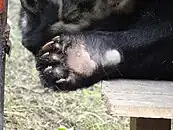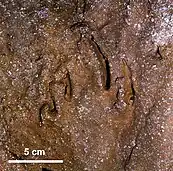| Arctodus Temporal range: | |
|---|---|
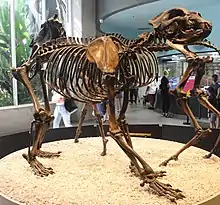 | |
| A. simus from the La Brea Tar Pits | |
| Scientific classification | |
| Domain: | Eukaryota |
| Kingdom: | Animalia |
| Phylum: | Chordata |
| Class: | Mammalia |
| Order: | Carnivora |
| Family: | Ursidae |
| Subfamily: | Tremarctinae |
| Genus: | †Arctodus Leidy, 1854 |
| Type species | |
| †Arctodus pristinus Leidy, 1854 | |
| Other species | |
| |
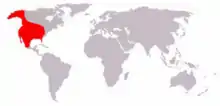 | |
| Arctodus simus range | |
| Synonyms | |
|
synonyms of A. simus synonyms of A. pristinus
| |
Arctodus is an extinct genus of short-faced bear that inhabited North America during the Pleistocene (~2.5 Mya until 12,800 years ago). There are two recognized species: the lesser short-faced bear (Arctodus pristinus) and the giant short-faced bear (Arctodus simus). Both species are relatively rare in the fossil record. A. pristinus was largely restricted to the Early Pleistocene of the eastern United States, whereas A. simus had a broader range, with most finds being from the Late Pleistocene of the United States, Mexico and Canada. A. simus evolved from A. pristinus, but both species likely overlapped in the Middle Pleistocene. Of these species, A. simus was larger, is known from more complete remains, and is considered one of the most charismatic of North America's megafauna.
Today considered to be an enormous omnivore, Arctodus simus is believed to be one of the largest known terrestrial mammalian carnivorans that has ever existed. However, Arctodus, like other bears, was highly sexually dimorphic- adult A. simus ranged between 300 to 950 kilograms (660 to 2,090 lb), with females clustering at ≤500 kilograms (1,100 lb), and males around 800 kilograms (1,800 lb). The largest males stood at 1.67 metres (5 ft 6 in) at the shoulder, and up to 3.4 metres (11 ft) tall on their rear legs. Studies suggest that Arctodus simus browsed on C3 vegetation and consumed browsing herbivores such as deer, camelids, and tapir. A. simus preferred open woodlands but was an adaptable species, taking advantage of many habitats and feeding opportunities.
Arctodus belongs to the Tremarctinae subfamily of bears, which are endemic to the Americas. Of these short-faced bears, Arctodus was the most widespread in North America. However, both species went extinct in the Pleistocene. A. pristinus went extinct around 300,000 years ago, with A. simus disappearing ~12,800 years ago in the Quaternary extinction event, one of the last recorded megafauna to go extinct in North America. The cause behind these extinctions is unclear, but in the case of A. pristinus, this was likely due to climate change and competition with other ursids, such as the black bear and Tremarctos floridanus. A. simus likely went extinct due to ecological collapse disrupting the vegetation and prey it relied on.
Taxonomy
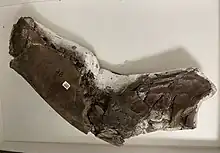
Arctodus was first described by Joseph Leidy in 1854, with finds of A. pristinus from the Ashley Phosphate Beds, South Carolina.[1][2][3] The scientific name of the genus, Arctodus, derives from Greek, and means "bear tooth". The first fossils of Arctodus simus were found in the Potter Creek Cave, Shasta County, California, by J. A. Richardson in 1878, and were initially described as Arctotherium simum by Edward Drinker Cope in 1879.[4][5][6] Historically, all specimens were grouped together under A. pristinus, until a revision by Björn Kurtén in 1967.[7]
In the 19th and early 20th centuries, specimens of Arctodus were occasionally referred to Arctotherium, and vice versa.[8][9][10][11][12] However, today neither genera are considered to have overlapped, with the closest point of contact being México, with the giant Arctodus simus in Valsequillo, Puebla,[7][13][14] and the smaller Arctotherium wingei in the Yucatán Peninsula.[15] Sometimes described as the "American cave bear",[4] Arctodus should not be mistaken for the similarly large Eurasian cave bear (Ursus spelaeus). As an ursine, the Eurasian cave bear last shared a common ancestor with the tremarctine Arctodus circa 13.4 million years ago.[16]
Fossils of Arctodus pristinus are often confused with the similarly sized, partially contemporaneous short-faced bear, Tremarctos floridanus.[1] Arctodus has higher crowned and considerably larger teeth than its relative Tremarctos. A. pristinus can be distinguished by broader and taller molars on average, but as they are often worn, differentiation can be difficult.[2] Moreover, diagnosing isolated A. simus remains (such as femora, scapulae, certain vertebrae, ribs, podials) from brown bears can be challenging, as some large brown bears overlap in dimensions with small Arctodus simus.[7]
Evolution
| Tremarctinae within Ursidae | |||||||||||||||||||||||||||||||||||||||||||||||||||
|
Arctodus belongs to the subfamily Tremarctinae, which appeared in North America during the earliest parts of the late Miocene epoch in the form of Plionarctos. The medium-sized Arctodus pristinus, Tremarctos floridanus and Arctotherium sp. evolved from Plionarctos in the Blancan age of North America.[2][17][18] The genetic divergence date for Arctodus is ~5.5 million years ago,[16] around the Miocene-Pliocene boundary (~5 Ma), when tremarctine bears, along with other ursids, experienced an explosive radiation in diversity, as C4 vegetation (grasses) and open habitats dominated. The world experienced a major temperature drop and increased seasonality, and a faunal turnover which extinguished 70–80% of North American genera.[19]
During the early Irvingtonian (~1.36 million years ago), a western population of A. pristinus evolved into the enormous A. simus, being first recorded from the Irvington type locality in California.[7][20] Although both Arctodus species co-inhabited North America for at least a million years during the Middle Pleistocene (A. pristinus went extinct ~300,000 BP), there is no direct evidence of overlap or competition in the fossil record as of yet, as both species established largely separate ranges.[18]
Arctodus pristinus was mostly restricted to the more densely forested thermal enclave in eastern North America.[21][22] A. pristinus has the greatest concentration of fossils in Florida, and is first known from the Santa Fe River 1 site of Gilchrist County.[2] Correspondingly, A. simus is most plentiful from western North America,[23][24] albeit preferring mixed habitat such as open woodlands.[25][26][27][28] Their ranges may have met in the Middle Pleistocene of Kansas,[7] with A. simus migrating east in the Late Pleistocene (around the extinction of A. pristinus).[18]
Irvingtonian age (1,900,000 BP-250,000 BP) specimens of Arctodus simus are particularly sparse. Finds are mostly from California, with additional remains from Texas, Kansas, Nebraska, and Montana.[29][30][31] However, A. simus became a pan-continental species in the Rancholabrean (Late Pleistocene), sharing that distinction with the black bear.[28] Despite Arctodus simus' large temporal and geographic range, fossil remains are comparatively rare (109 finds as of 2010, in otherwise well-sampled localities).[18][16]
Description
Size
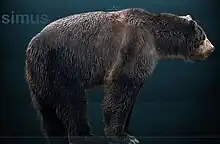
Arctodus pristinus
A. pristinus specimens closely overlap the size of Tremarctos floridanus, with the some males of A. pristinus overlapping in size with the females of A. simus.[1] A. pristinus individuals recovered from the Leisey Shell Pit, Florida, were calculated to an average of ~133 kilograms (293 lb).[32] However, as the dimensions of some individuals from Port Kennedy Bone Cave and Aguascalientes are within A. simus range, northern and western A. pristinus may have been larger than Floridan A. pristinus.[7]
Arctodus simus
Some A. simus individuals might have been the largest land-dwelling specimens of Carnivora that ever lived in North America. Standing up on its hind legs, A. simus stood 2.4–3.4 m (8–11 ft).[33][34] When walking on all fours, A. simus stood 1–1.67 m (3.3–5.5 ft) high at the shoulder, with the largest males being tall enough to look an adult human in the eye.[35][34][36] The average weight of A. simus was ~625 kilograms (1,378 lb), with the maximum recorded at 957 kilograms (2,110 lb).[37]
Studies
In a 2010 study, the mass of six A. simus specimens was estimated; one-third of them weighed about 850 kg (1,874 lb), the largest from Salt Lake Valley, Utah coming in at 957 kg (2,110 lb), suggesting larger specimens were probably more common than previously thought. However, half the specimens were calculated to be less than 500 kg (1,100 lb). The weight range calculated from all examined specimens was between 957 kg and 317 kg (699 lb).[37] Hypothetically, the largest individuals of A. simus may have approached 1,000 kilograms (2,200 lb),[38] or even 1,200 kg (2,600 lb).[39] However, a 2006 study argued that the maximum size of Arctodus was ~555 kilograms (1,224 lb), based on the largest known skull.[40] Additionally, a 1998 study calculated the average weight of Arctodus specimens from the La Brea Tar Pits at ~372 kilograms (820 lb), smaller than recovered brown bear remains (~455 kilograms (1,003 lb), although these remains postdate Arctodus).[41][42][43] A 1999 study by Per Christiansen calculated a mean weight of ~770 kilograms (1,700 lb) from six large male A. simus specimens.[38]
Sexual dimorphism

There is much variation in adult size among specimens- the lack of finds, sexual dimorphism, individual variation and potentially ecomorphs could be augmenting the average size of both species of Arctodus.[2][7][44] Size differences between specimens of Arctodus simus (such as skull and long bone dimensions) have led to the suggestion of a larger northern/central subspecies (A. s. yukonensis) and southern subspecies (A. s. simus).[37][7][31] Indeed, Kurtén hypothesized the evolution of A.s. yukonensis in the Irvingtonian, with A.s. simus emerging in the Rancholabrean.[31][7] However, the discovery of a very large southern Arctodus simus in Florida (deep within the supposed range of A. s. simus),[18] & possibly Rancho La Brea,[7] and a notably small specimen from the Yukon,[16] put doubt on this designation. Perceived ecomorphologies are possibly due to the low number of specimens, and sex-biased sampling.[18]
For example, only one baculum (penis bone) has been recovered from over 100 giant short-faced bear sites in North America (Potter Cave). The majority of large individuals are from open sites, where usually only a few elements were recovered. In contrast, cave passages produced numerous examples of small, yet relatively complete individuals where bacula would likely be found if they had been present. Both the small size of recovered individuals and the lack of bacula from cave deposits suggest that mostly female individuals of A. simus were using caves.[45][46][7] Therefore, in conjunction with ursid sexual dimorphism (e.g. male spectacled bears are 30%-40% larger than females), the larger, massive Arctodus individuals are often considered male, particularly older males, with the smaller, more lightly built individuals being females.[18][47][29] Sexual dimorphism may also explain A. simus teeth (from multiple individuals from the same site) generally clustering into two sizes.[7]
Convergent evolution
Both giant short-faced bears Arctodus simus and Arctotherium angustidens reached huge body sizes, in an example of convergent evolution.[48] However, beyond gigantism, there are notable differences between the species. Not only did Arctotherium angustidens reach a higher maximum weight (an exceptional specimen was calculated at ~1,670 kilograms (3,680 lb)), A. angustidens was a much more robust animal, in contrast with the gracile Arctodus simus.[39] Excluding the exceptional specimen, Arctotherium angustidens had been calculated to a weight range between 1,200 kilograms (2,600 lb) and 412 kilograms (908 lb),[49][37] with the largest specimens of either species being said to be comparable to one another.[49][50]
The panda-relative Agriotherium africanum has also been suggested to share ecomorphological convergences with Arctodus simus. Together with great size, the two species converged on several adaptations, including a skull with a short broad rostrums, premasseteric fossa on the mandible, possible carnassial shears (P4 and m1), and long limbs (relative to body length). These features were also shared by other species of Agriotherium/Huracan and by Arctotherium bonariensis.[40] However, while Agriotherium & Huracan have definitive adaptions for meat-heavy diets stemming from a running, predatory lifestyle, Arctodus simus lacks similar adaptations beyond proportionally longer limbs.[51]
Anatomy
The two species of Arctodus are differentiated not only by size, but also by the shorter snout, greater prognathism, more robust teeth and longer limbs of A. simus, and the relative proportions of each species' molars and premolars. Arctodus pristinus is distinguished from A. simus smaller, narrower, and less crowded teeth. However, the morphologies of both species are otherwise very similar. As a result, differentiating Arctodus simus from Arctodus pristinus can be difficult, as male individuals of Arctodus pristinus can overlap in size with female individuals of Arctodus simus.[18][45][52] Arctodus simus superficially resembled living hyaenids in skull shape and relative lengths of the trunk, back and limbs.[40] The most nearly complete skeleton of A. simus found in the US was unearthed in Fulton County, Indiana; the original bones are in the Field Museum of Natural History, Chicago.[35][53]
Skull
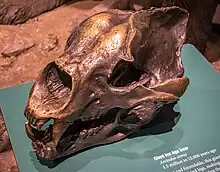
Members of the Tremarctinae subfamily of bears appear to have a disproportionately short snout compared with most modern bears, giving them the name "short-faced." Arctodus has also been argued to exhibit a wide and shortened rostrum, potentially giving Arctodus a more felid-like appearance. This broad snout could have housed a highly developed olfactory apparatus, or accommodated a larger throat passage to bolt down large food items, akin to spotted hyenas.[38][23][54][55] However, this apparent shortness is an illusion caused by the deep snouts and short nasal bones of tremarctine bears compared with ursine bears; Arctodus has a deeper but not a shorter face than most living bears. This characteristic is also shared by the only living tremarctine bear, the omni-herbivorous spectacled bear.[37][50] Snout deepness could be variable, as specimens from Huntington Reservoir in Utah, and the Hill-Shuler locality, Texas, were noted as being distinctly "short-faced" in comparison with other Arctodus simus individuals.[56][57]
The orbits of Arctodus are proportionally small compared to the size of the skull, and somewhat laterally orientated (a characteristic of tremarctine bears), more so than actively predatory carnivorans or even the brown bear, suggesting that stereoscopic vision was not a priority.[40][50][58] As with Tremarctos ornatus, specimens with a large sagittal crest were likely male, whereas females had a reduced or no sagittal crest.[2] Although there are limited samples, the middle ear bones of A. simus are proportionally larger than modern ursine bears, suggesting the species was particularly attuned to low-frequency sounds.[59]
Morphologically, Arctodus simus exhibits masticular characteristics common to herbivorous bears. This includes cheek teeth with large, blunt surface areas, a deep mandible, and large mandibular muscle attachments (which are rare in carnivorous mammals). Because herbivorous carnivorans lack an efficient digestive tract for breaking down plant matter via microbial action, they must break down plant matter via extensive chewing or grinding, and thus possess features to create a high mechanical advantage of the jaw, which was present in Arctodus.[23][60][61] However, the low mandibular condyle relative to the tooth row (and therefore potential wide gape) of Arctodus has been inferred as an adaptation for carnivory.[31][62][63] An analysis of the mandibular morphology of tremarctine bears found that Arctodus pristinus and Arctodus simus were divergent in the dimensions of their cranial anatomy, with Arctodus simus clustering tightly with Arctotherium angustidens, suggesting a similar foraging strategy. A. simus specimens have a concave jaw, large masseter and temporalis muscles, deeper horizontal ramus and a reduced slicing dentition length, when compared to A. pristinus. However, both species of Arctodus and Arctotherium angustidens were still found to be comfortably in the "omnivorous" bear cranio-morphotype.[50]
Dentition
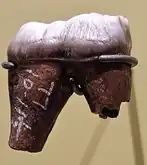
The premolars and first molars of Arctodus pristinus are relatively smaller and more widely spaced than those of Arctodus simus.[1][18] In A. pristinus, the features of the dentition can be quite variable, particularly the M2 molar.[2] The teeth of A. pristinus transition between undulating to acute-angled Hunter-Schreger bands while A. simus exhibited a transition between undulating to zigzag bands, demonstrating an evolution towards reinforced tooth enamel. This has been convergently evolved with giant pandas, Agriotheriin bears, and Hemicyon.[64]
The dentition of A. simus has been used as evidence of a predatory lifestyle- in particular the large canines, the high-crowned lower first molar, and the possible carnassial shear with the upper fourth premolar. However, the wearing of the molars to a relatively flat, blunt loph (suitable as a crushing platform as per modern omnivorous bears), small shear facet, and the flattened cusps across age ranges (unlike carnivores, which instead have carnassial shears) disagrees with this hypothesis.[23][65]
Dentition can be a poor indicator of size in A. simus, as some medium-size individuals have teeth that surpass the size of those with the largest skeletons.[7][66] Additionally, while A. simus evolved from the smaller A. pristinus, their teeth remained generally the same size.[7] A specimen of A. simus from the Seale Pit of the Hill-Shuler locality, Texas, with only two premolars, crowding of the anterior premolar out of line, and a wider and shorter muzzle, was suggested to be an undescribed form of Arctodus.[57]
Post-cranial
Limbs
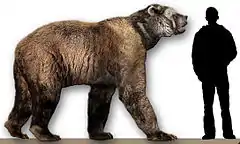
Researchers have differing interpretations on the limb morphology of Arctodus. A comprehensive 2010 study concluded that the legs of Arctodus weren't proportionally longer than modern bears would be expected to have, and that bears in general are long-limbed animals, obscured in life by their girth and fur. The study concluded the supposed "long-legged" appearance of the bear is largely an illusion created by the animal's relatively shorter back and torso. In fact, Arctodus probably had an even shorter back than other bears, due the necessary ratio between body length and body mass of the huge bear.[37][67]
However, other researchers argue that the limb bones of Arctodus simus are proportionally longer than those of other bears, leading to a "gracile" appearance. Although longer, the proportions still overlap with Ursus, and the limb bones are stouter than in the large-bodied felids (Panthera). Rather than for running, these elongated limb bones may have evolved for increased locomotor efficiency during prolonged travel.[51][68] Some researchers suggest that proportionally longer limbs may be an adaptation for increased vision over tall ground cover in an open habitat, or were used in tearing and pulling down vegetation,[23][36] as the spectacled bear (Tremarctos ornatus), the closest living relative of Arctodus, shares various adaptations for herbivory with Arctodus.[37]
Researchers also disagree when interpreting the humerus of Arctodus simus.[51] Sorkin argued that the pronation of the forearm and the flexion of the wrist and digits, and more lightly muscled forelimbs, all of which are crucial to grasping a large prey animal with the forepaws, were probably less powerful in Arctodus than in either the brown bear or in Panthera. This is due to a weak medial epicondyle and reduced development of the pronator teres muscle.[40] Furthermore, the forelimb of Arctodus could have been in the early stages of cursorial evolution, being capable of more efficient and high-speed straight-line locomotion (relative to extant bears), and was possibly more adept at pursuing large prey than polar and brown bears.[69][51]
However, some researchers argue that the epicondyles were still well developed.[51] The shape of the elbow joint, along with an well-developed medial epicondyle which forms an angle with the condyle, and shallower olecranon fossa, would have given Arctodus a higher degree of forelimb dexterity. Originally evolved to facilitate arboreality, researchers believe that the terrestrial Arctodus (along with Arctotherium and the giant panda) retained this characteristic to assist in foraging for vegetation.[48][23][70] Other researchers believe that this wide range of ulna rotation suggests that forearms of Arctodus were powerful and could subdue large prey.[51]
Paws
The paws (metapodials and phalanges) of Arctodus were characteristically long, slender, and more elongated along the third and fourth digits compared to ursine bears. Arctodus' paws were therefore more symmetrical than ursine bears, whose feet have axes aligned with the most lateral (fifth) digit. Also, the first digit (hallux) of Arctodus was positioned more closely and parallel to the other four digits (i.e. with straight toes, Arctodus had less lateral splaying).[67][36]
This theory is potentially contradicted by trackways tentatively attributed to Arctodus simus from near Lakeview in Oregon. The trackways exhibit extreme toe splaying, with three centrally aligned, evenly spaced toes at the front, and two almost perpendicular toes (80° from the axis of the foot on either side). The trackways suggest that Arctodus had an oval-shaped, undivided pad on its sole, front paws that were slightly larger than its back paws, possessed long claws, and had its hind foot overstep the forefoot when walking, like modern bears.[72] Some claw marks attributed to Arctodus simus at Riverbluff Cave (as they were four meters above the floor of the cave) were nearly 20 cm in width.[73][74] The presence of a partial false thumb in Arctodus simus is a characteristic shared with Tremarctos floridanus and the spectacled bear, and is possibly an ancestral trait. Absent in ursine bears, the false thumb of the spectacled bear has been suggested to assist in herbivorous food manipulation (such as extracting mast, e.g. bromelaid/palm hearts), or arboreality.[75]
Locomotion
Paul Matheus proposed that Arctodus may have moved in a highly efficient, moderate-speed pacing gait, more specialized than modern bears. His research concluded that the large body size, taller front legs, high shoulders, short and sloping back, and long legs of Arctodus also compounded locomotive efficiency, as these traits swelled the amount of usable elastic strain energy in the tendons, and increased stride length, making Arctodus built more for endurance than for great speed.[33][68] His calculations suggested that Arctodus likely had a top speed of 40–45 kilometres per hour (25–28 mph), and based on hyaenid proportions, would shift from singlefoot locomotion to a pace at 8.5 km/h (5.3 mph), and would begin to gallop at 18.5 km/h (11.5 mph), a fairly high speed. Based on other mammals, the optimal pace speed of Arctodus would have been 13.7 km/h (8.5 mph), which would have also been rather fast for moderate speed travel. For comparison, hyenas cross country ~10 km/h (6.2 mph).[68]
Maturity
Examinations on a mostly full sized young individual of Arctodus simus from an Ozark cave suggest that Arctodus, like other ursids, reached sexual maturity well before full maturity. Comparisons with black bears suggest the Arctodus specimen was either 4–6 years of age if female, or 6–8 years if the specimen was male. Additionally, wear patterns on the individual's teeth are similar to a 4-6 year old Ursus americanus. Fused sutures, epiphyses, and epiphyseal plates, along with tooth eruption, have been used to determine adulthood in Arctodus.[45][16]
Genetic diversity
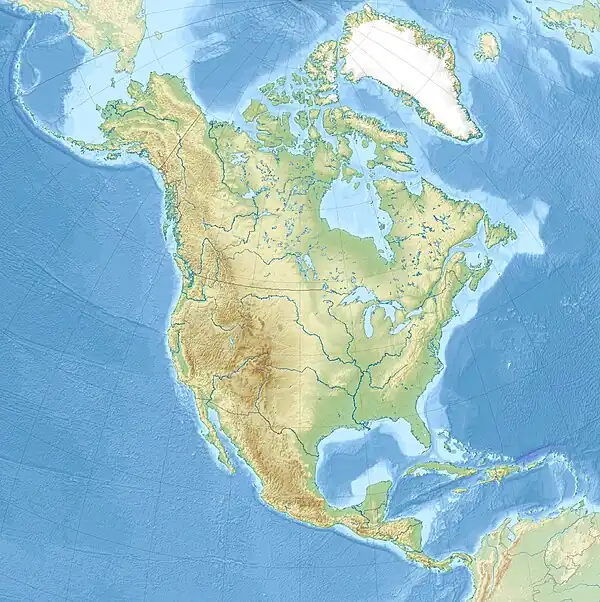
Legend: ![]() Main mitochondrial haplogroup of A. simus (haplotypes A, B, C, D, E, F, G)
Main mitochondrial haplogroup of A. simus (haplotypes A, B, C, D, E, F, G)
![]() Chiquihuite Cave A.simus
Chiquihuite Cave A.simus
An examination of mitochondrial DNA sequenced from specimens of Arctodus simus from Alaska, Yukon, Alberta and Ohio suggest an extremely low level of genetic diversity among the 23 individuals studied (≤ 44,000 14C BP), with only seven haplotypes recovered. Genetic diversity was comparable to modern endangered fauna, such as the brown kiwi and African cheetah. Explanations include a genetic bottleneck before 44,000 14C BP, or a low level of genetic diversity being a feature of a species which was primarily solitary, with a large home range and relatively small population size.[76] However, this does not entirely preclude genetic diversity in Arctodus simus, with genetic samples from Chiquihuite Cave, Zacatecas (~14,000 BP), indicating a deep divergence with previously studied specimens of A. simus.[16] An additional specimen from Wyoming has been sequenced, but is unassigned.[77]
Haplotype cladogram
Below is a cladogram exploring the relationships between the mitochondrial haplogroups of Arctodus simus. Other than the specimen from Chiquihuite Cave, all haplotypes form a single monophyletic clade.[16][76]
|
| ||||||||||||||||||||||||||||||||||||||||
| ||||||||||||||||||||||||||||||||||||||||
Paleobiology
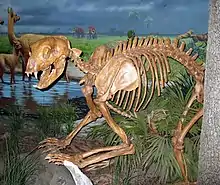
Arctodus pristinus
Paleoecology
Although smaller than its descendant, Arctodus pristinus was still a relatively large tremarctine bear.[1] Sometimes referred to as the eastern short-faced bear,[78] A. pristinus has been found in Florida, Kansas, Maryland and Pennsylvania, South Carolina, and West Virginia in the US, and Aguascalientes in Mexico.[2][79][80][81] A. pristinus is particularly well known from Florida, especially from the Leisey Shell Pit.[82] Like A. simus and other tremarctine bears, A. pristinus had adaptations for herbivory, and was likely largely herbivorous itself.[2]
Competition with other ursids
In the Early Pleistocene, Arctodus pristinus was much more populous the south-east of North America, whereas the black bear was more common in the north-east.[83] A partially contemporary tremarctine bear inhabiting western North America, Tremarctos floridanus are very similar to A. pristinus in terms of size, skeletal anatomy, and dietary preferences.[2]
Despite this, generally speaking large tremarctine fossils from the Early and Middle Pleistocene of Florida are considered to be A. pristinus, whereas those from the Late Pleistocene of Florida are considered to be T. floridanus. Indeed, black bears and Tremarctos floridanus are believed to have only colonized Florida with the extinction of A. pristinus (both of which only appear in Florida in the Late Pleistocene), however, T. floridanus could yet still be found from older sites in Florida.[2] T. floridanus was possibly being an ecological replacement of A. pristinus, with T. floridanus finds being widespread in Rancholabrean Florida and the wider southeastern United States.[2][22][28]
The evolution of Arctodus simus, competition with Tremarctos floridanus and black bears, and possibly the transitioning of Pleistocene Florida from a hot, wet, densely forested habitat to a still hot, but drier and much more open biome are thought to be factors behind the gradual disappearance of Arctodus pristinus in the Middle Pleistocene (300,000 BP).[18][28] There are unreliable records of A. pristinus in South Carolina, California and Florida in the Late Pleistocene, suggesting a possible survival as a relict species in refugia until the Quaternary extinction event.[84][79][28]
Hibernation
Arctodus pristinus specimens have been found in caves such as Port Kennedy, Pennsylvania (where fossils from as many as 36 individuals have been found), and Cumberland Cave, Maryland, often in association with the black bear. This suggests a close association with the biome.[2][81]
Arctodus simus
Paleoecology
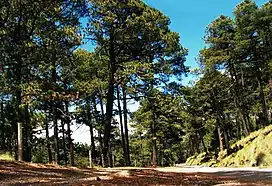
Evolving from the smaller A. pristinus around 1.36 million years ago, scholars today mostly conclude that Arctodus simus was a colossal, opportunistic omnivore, with a flexible, locally adapted diet akin to the brown bear.[37][85][50][63] If Arctodus simus wasn't largely herbivorous,[2][23] the scavenging of megaherbivore carcasses, and the occasional predatory kill would have complimented the large amounts of vegetation consumed when available.[37][40] Carbon-13 (δ13C) isotope data gathered from Arctodus specimens from Beringia, Vancouver Island, California, Mexico and Texas, indicates that Arctodus simus had a diet based on C3 resources, primarily from mixed habitats (such as open woodlands).[25][26][86][87][88][89] This includes C3 vegetation (leaves, stems, fruits, bark, and flowers from trees, shrubs, and cool season grasses)[23] and the browsers that fed on them, such as deer, camelids, tapir, bison and ground sloths.[26][37]
Primarily inhabiting a range from southern Canada to central Mexico in the west, to Pennsylvania and Florida in the east,[7][18][90] A. simus also inhabited Beringia between ~50,000 BP to ~23,000 BP. Finds today span from northern Alaska to the Yukon.[16][18][90] Based on the wide distribution of the species, Arctodus simus inhabited a diversity of climatic conditions and environments,[18][23][91] ranging from boreal forests and moist tundra in the north,[92] the montane woodlands of the US Interior Highlands,[28] the pluvial lakes and piñon–juniper woodland of the inland western USA,[93] subtropical woodlands and mixed savannas of the south-western USA and Mexican Plateau,[22][25][26] to the pine–oak forests of the Trans-Mexican Volcanic Belt, the boundary of the Nearctic realm.[13]
Sometimes referred to as the bulldog bear,[94][95] or great short-faced bear,[96] Arctodus simus has been recovered from a comparatively small number of finds in relation to other large carnivorans, with the species suggested to have lived in low population densities.[16] However, A. simus was relatively plentiful in western North America, with over 50% of specimens from the contiguous United States (<40,000 BP).[28][91] Arctodus simus was integral to what has been referred to as the Camelops fauna, or alternatively Camelops/Odocoileus lucasi ("Navahoceros") fauna, a faunal province centered in western North America. The Camelops fauna was also characterized by shrub-ox, prairie dogs, dwarf pronghorns, Shasta ground sloths, and American lions. The diverse flora of the Camelops faunal province included montane conifers and oak parklands, shrub and grassland that stretched across the North American Cordillera south of Canada, to the Valley of Mexico. This faunal province supported a variety of large grazing and browsing mammals.[24][97][98]
Competition with ursine bears
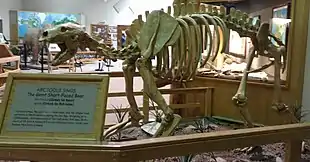
Black bears have inhabited North America since at least the Middle Pleistocene, whereas brown bears (along with lions, bison and red foxes) first emigrated to North America via Beringia during the Illinoian Glaciation. The North American lineage of brown bears developed around ~177,000 BP, with fossils being first recovered ~111,000 BP from East Beringia. Genetic divergences suggest brown bears first migrated south during MIS-5 (~92,000-83,000 BP) upon the opening of the ice-free corridor,[92][99] with the first fossils being near Edmonton (26,000 BP).[63]
The most commonly accepted ecological parallel of Arctodus simus in scientific literature is the brown bear.[37][50][63] Both brown bears and Arctodus simus exhibit a high degree of dietary variability, and while largely herbivorous, meat can be an important dietary element to certain populations of both species.[87] Additionally, the potential of habitual kleptoparasitism is often noted in Arctodus, with brown bears being opportunistic, curious, and regularly stealing kills from smaller predators.[67][87]
One theory behind the extinction of Arctodus simus is that A. simus may have been out-competed by brown bears as the latter expanded southwards from eastern Beringia ~13,000 BP, and gradually established itself in North America.[42] However, this has been refuted by more recent research, as new dates establish an extended coexistence.[92][63] On a continent-wide scale, although the brown bear and Arctodus simus were sympatric at times as brown bears spread through North America, Arctodus simus may typically have dominated competitive interactions, and displaced brown bears from specific localities. At the end of the Pleistocene, one reason brown bears persisted where Arctodus simus went extinct was because Arctodus may have been less flexible in adapting to new and rapidly changing environments that impacted the availability or quality of food and habitat.[63] Brown bears and Arctodus have been discovered together in Alaska (then Beringia) between 50,000 BP-34,000 BP,[92] and in later Pleistocene deposits in Vancouver Island, California, Wyoming and Nevada.[7][63]
Beringia
Isotope values (δ13C and δ15N) in numerous Beringian Arctodus simus specimens suggests A. simus usually occupied a higher trophic level compared with invading brown bears. While some Beringian brown bears consumed salmon as well as vegetation, reduced signatures of terrestrial meat consumption were noted. On the other hand, data from Beringian specimens of Arctodus suggest that while omnivorous, only terrestrial sources of meat were important for Beringian Arctodus.[54]
That Arctodus simus (along with local climate change) may have excluded brown bears from Eastern Beringia from ~34,000 to ~23,000 BP further suggests that Arctodus may typically have been dominant over brown bears.[100][101] When Arctodus went extinct in Beringia ~23,000 BP, brown bears recolonized Beringia, but had more carnivorous diets than their Beringian kin pre ~34,000 BP. This bolsters the idea that these bears competed for similar resources and niches.[92][63]
Extinction and repopulation is further evidenced by the high genetic (mitochondrial) diversity of Beringian brown bears in contrast with Beringian Arctodus simus. This contrast in genetic diversity has also been hypothesized to suggest that while female brown bears have a permanent home range, female Arctodus simus may not have (at least not to the same extent).[76][92]
The forcing of a smaller bear into a more herbivorous diet has been compared to the modern relationship between brown bears and American black bears.[67][87] Where they overlap, brown bears are observed to take over the higher trophic niche, with lower population densities, much smaller territorial ranges, and the seasonal migration of black bears in areas where brown bears are also present.[99]
_running.jpg.webp)
Vancouver Island
Although a 2018 study hypothesized that both species did not overlap territorially on Vancouver Island,[63] a revision of radiocarbon dates by a 2022 study concluded that brown bears, black bears and Arctodus simus all co-existed on Vancouver Island once the island de-glaciated ~14,500 BP. According to an isotope analysis, all three bears relied on terrestrial resources, with black bears occupied a distinctly lower trophic position in relation to the brown bear, with Arctodus holding an intermediate position. This may be an underestimate, as the Arctodus specimens from Vancouver Island are believed to be female; modern female brown bears have a significant decrease in protein consumption compared with male brown bears where they co-exist with black bears. Additionally, an analysis of Arctodus' data suggested that when consuming protein, meat was preferred.[99]
It is possible that the each species was specialized to different environmental settings, which vary greatly across small geographical areas on the mountainous island. The standard differentiation between the more open adapted brown bear and closed forest-adapted black bear is complicated by competition from Arctodus simus, which seems to have also preferred more open habitat.[99]
Hibernation
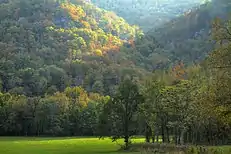
According to a 2003 study, in karst regions, fossils of Arctodus simus have been recovered almost exclusively from cave sites. In the contiguous United States, 26 of 69 Arctodus simus sites (~38%) are in caves. That greater than one-third of all sites are caves suggests a close association between this species and cave environments. Furthermore, over 70% of the smaller specimens (once assigned as the A. s. simus subspecies) are from cave deposits. Not one of the specimens assigned to the larger morph (A. s. yukonensis) is from a cave passage. Taking into account that female ursids are smaller and more prone to den in caves, it is likely that the majority of Arctodus simus from such deposits were females and may have been denning when they perished.[45] At Riverbluff Cave, the most abundant claw marks are from Arctodus simus- some are up to 4 meters high on the cave walls. They are most abundant at the bear beds and their associated passageways, indicating a close relationship with denning.[73]
Female specimens of Arctodus simus have been inferred to have been exhibiting maternal denning, however the expression of metabolic denning (hibernation/torpor) is unclear in Arctodus.[46] Moreover, to date, there are no records of adults with associated offspring from caves.[47] However, Arctotherium angustidens, a fellow giant short-faced bear, has been recovered from a cave in Argentina with offspring.[102]
Numerous "bear" beds often preserve Arctodus simus and both Pleistocene and modern American black bears in association (U.a. amplidens and U. a. americanus)- such deposits have been found in Missouri, Oklahoma and Potter Creek Cave, California. These mixed deposits are assumed to have accumulated over time as individual bears (including Arctodus) died during winter sleep.[5][103][104] Furthermore, environmental DNA suggests that Arctodus and black bears shared a cave in Chiquihuite cave, Zacatecas.[16]
At the Labor-of-Love cave in Nevada, both American black bears and brown bears have been found in association with Arctodus simus. A study in 1985 noted that sympatry between Arctodus and brown bears preserved in caves is rare, with only Little Box Elder Cave in Wyoming and Fairbanks II site in Alaska hosting similar remains.[23][42]
Paleopathology
Beyond carbohydrate-associated dental pathologies present in the genus,[45][91] extensive pathologies have been preserved on the most nearly complete skeleton of Arctodus. One hypothesis suggests the Fulton County Arctodus specimen suffered from a syphilis-like (treponemal) disease, or yaws, based on the various lesions present.[35][105][106] However, alternate hypotheses include tuberculosis, osteomyelitis, arthritis or a fungal infection, either singularly or in combination with other causes. The same individual records a pathological growth distorting the right humerus,[40] with abscesses are noted between the molars and on both ulna. Hypotheses include syphilis, osteoarthritis, a fungal infection in addition to long term syphilis, or an infected wound.[35][107] Several specimens from Fairbanks, Alaska, also exhibit either pathological growths or periodontal disease.[7]
Map of fossil localities

Legend: ![]() A. pristinus
A. pristinus
![]() Early/Middle Pleistocene (Irvingtonian) A.simus
Early/Middle Pleistocene (Irvingtonian) A.simus
![]() Late Pleistocene (Rancholabrean) A. simus
Late Pleistocene (Rancholabrean) A. simus
Distribution & habitat
Regional Paleoecology
Arctodus pristinus
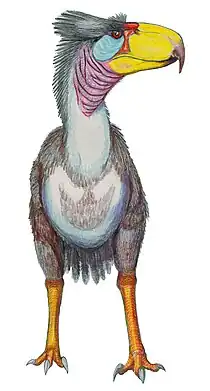
Eastern North America
Arctodus pristinus is considered a biochronological indicator for the period between the Late Blancan and late Irvingtonian periods of Pleistocene Florida- more fossils of Arctodus pristinus are known from Florida (about 150) than anywhere else.[2] In the Early Pleistocene of Blancan Florida, the Santa Fe River 1 site (~2.2 Ma), which Arctodus pristinus inhabited, was a fairly open grassland environment dotted with karst sinks and springs, dominated by longleaf pine flatwoods. Arctodus pristinus co-existed with terror birds, sabertooth cats, giant sloth (Eremotherium, Paramylodon, Megalonyx), giant armadillos (Holmesina, Glyptotherium, Pachyarmatherium), gomphotheres, hyenas, canids (Borophagus, Canis lepophagus), peccaries, llamas, dwarf pronghorns, and three-toed horses. Smaller fauna included condors, rails, ducks, porcupines, and alligators.[108][109]
Arctodus simus
Pacific Mountain System
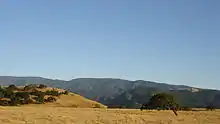
The Pacific Mountain System seems to represent a cradle of evolution for Arctodus simus. The earliest finds of Arctodus simus are from California, from early and middle Irvingtonian age sites such as Fairmead,[110] Irvington,[111] Riverside County,[29] and Vallecito Creek.[112]
Despite the shift to aridified environments from the Early to Late Pleistocene of the Central Valley (1.1Ma to ~15,000 BP), Arctodus simus remained consistent with the consumption of C3 resources. This period saw the evolution from wetter mixed woodland-grassland and marsh/prairie C3 dominated environs at Irvington and Fairmead, to the more arid, mixed C3-C4 savannas of the McKittrick Tar Pits. Dire wolves and Arctodus simus were consistent members of the local predator guild throughout the Pleistocene, whereas jaguars, Homotherium, Miracinonyx and Smilodon transitioned to Panthera atrox and coyotes.[25] In addition to browsing, Arctodus could have competed with other closed habitat browser specialists such as Smilodon and Panthera atrox for deer (Cervus & Odocoileus), camelids (Hemiauchenia & Camelops), Paramylodon, and peccaries.[25] However, specimens collected from the La Brea Tar Pits show evidence that A. simus preferred a specialized, herbivorous diet. A. simus is particularly famous from fossils found in the La Brea Tar Pits, with at least 30 individuals recovered.[113][60] Many more finds come from across California,[7][5] and Vancouver Island,[63][86] where the semi-arid woodland/scrub transitioned to forest-steppe,[114] and open grasslands/heath.[86]
Comparatively, the Rocky Mountain System had the fewest number of specimens of Arctodus simus in western North America.[28] However, one of the youngest dated Arctodus simus is from a cave near Huntington Reservoir, Utah, which sits at an elevation of 2,740m (~9,000 ft). The central and southern Rocky Mountains may have acted as refugia for Arctodus simus, in addition to other contemporary high-elevation alpine fauna such as Colombian mammoths, mastodon, horses, and giant bison ≤11,400 BP (10,000 14C BP).[56][24][115] Other remains have been found from Wyoming (such as Natural Trap Cave),[116][117] and Montana.[118][119]
Intermontane Plateaus
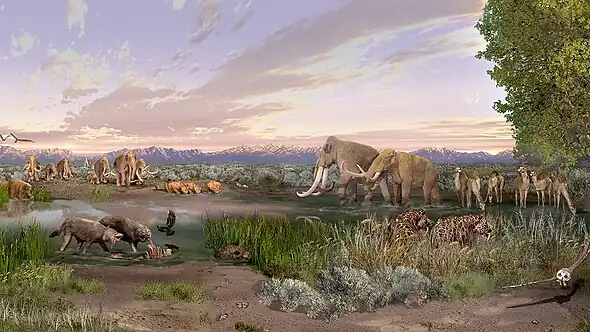
The Intermontane Plateaus had the highest number of Arctodus simus specimens south of the ice sheets.[28] The region has yielded some of the largest specimens of A. simus, including, what was once the largest specimen on record, from Salt Lake Valley, Utah.[44] In contrast with other parts of North America, the plateaus received more rainfall during the Late Pleistocene, as glacially cooled air collided with hot desert air. As a result, this greatly expanded the range of subalpine parkland, woodlands and pluvial lakes where desert exists today.[114] The mid-Wisconsian U-Bar Cave, New Mexico, was vegetated by sagebrush, grasses, and woodlands. Notable fauna which lived alongside Arctodus simus included Shasta ground sloth, shrub-ox, pronghorns (Stockoceros, Capromeryx), Camelops, Odocoileus, horses, Lynx, puma, black bear, mountain goats, prairie dogs, and Stock's vampire bat.[27][120] Dire wolves were also found in association with Arctodus simus, and both species are the most common carnivorans of Rancholabrean New Mexico.[121] Beyond Utah and New Mexico,[122][123][124][125][126] other important US specimens have also been found in Arizona,[7] eastern California,[127] Idaho,[7] Nevada,[128] and eastern Oregon.[129][130][131]
The Intermontane Plateaus extended deep into Mexico, where tremarctine bears (Arctodus simus & Tremarctos floridanus) were dominant.[28] Arctodus simus was limited to the Mexican plateau, which was generally occupied by tropical thorn scrub and scrub woodland.[132][114] An Arctodus simus individual from Cedral, San Luis Potosí, inhabited closed vegetation, based on the individual's δ13C signature. Consuming C3 resources, its diet may have incorporated local C3 specialists such as tapir, llamas, camels, and Shasta ground sloth along with browsed vegetation. The site, incorporating trees, herbs and cacti, hosted an open gallery forest near grassland or scrub with a humid climate. This biodiverse forest-savanna mosaic was part of the wider mesic savanna and piñon–juniper woodland ecoregion which Arctodus inhabited in the Late Pleistocene central Mexico and southwestern USA.[26][133][134] Similar highland remains have been recovered from Jalisco,[135] Michoacán,[132] Puebla,[7] State of Mexico,[136][137] and Zacatecas.[16]
Interior Plains
The Interior Plains were composed of temperate steppe grassland,[114] and among the specimens yielded from this region is one the largest Arctodus simus currently on record, from the banks of the Kansas river.[138] The late Irvingtonian Doeden gravel pits in Montana preserves an open grassland habitat, with riparian woodlands, and likely some shrublands.[139] Arctodus simus co-existed with ground sloths (Megalonyx, Paramylodon), Pacific mastodon, camels, and Bootherium.[140][141][30] As bison were yet to migrate into North America, Columbian mammoths and horses dominated these early Illinoian grasslands.[142]
.jpg.webp)
In the Rancholabrean age, Arctodus simus, grey wolves and coyotes were part of a predator guild throughout the great plains, and were joined by Columbian mammoths, camels, Hemiauchenia, and American pronghorns. While the northern plains aridified into cold steppe (e.g. Mammoth site, South Dakota),[143] the southern plains were a parkland with riparian hackberry forests, and large expanses of mixed grass prairie grasslands grading into wet meadows, with limited seasonality. In the south (Lubbock Lake, Texas), this fauna was joined by Smilodon, dire wolves, grey fox and red fox, preying upon prairie dogs, horses (Equus & Haringtonhippus), peccaries, Odocoileus, Capromeryx, Bison antiquus and Holmesina.[143][144] Beyond Texas,[145] Arctodus has also been found in Iowa,[146] Kansas,[7][147] Nebraska,[7] and southern Canada (Alberta & Saskatchewan),[148][149][150] which when unglaciated, would have formed a tundra ecosystem with an ice-free corridor to Beringia.[151]
In the lowlands of the eastern Interior plains, the plains transitioned to closed habitat. At the terminal Pleistocene Sheriden Cave, Ohio, a mosaic habitat consisting of marsh, open woodland, and patchy grassland was home to Arctodus simus, Cervalces scotti, caribou, peccaries (Platygonus, Mylohyus), giant beaver, porcupine, and American pine marten.[152][153] Similar remains have been found in Indiana,[35] and Kentucky.[154][155]
Interior Highlands
To the south, the Interior Highlands had a very high density of Arctodus simus specimens (second only to the black bear),[28][91] due to the high rate of preservation in the cave-rich region. Sympatry between the two species is most apparent in Missouri- Arctodus simus has been found in association with black bears at Riverbluff, Bat and Big Bear caves.[156] Big Bear Cave preserves fossilized hair associated with Arctodus.[45] During the Last Glacial Maximum, both bears were joined by dire wolves, coyotes, jaguars, snowshoe hare, groundhogs and beavers at Bat Cave, which also records thousands of Platygonus remains. These fauna inhabited well-watered forest-grassland ecotone with a strong taiga influence, although the region did occasionally cycle through drier, grassier periods. These open woodlands were dominated by pines and spruce, and to a lesser extent by oaks.[157][158][159][160][161]
Eastern USA
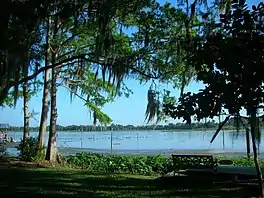
Compared to other regions, Arctodus simus was relatively rare in eastern North America.[18][28][91] To the north, the Appalachian Highlands were dominated by taiga.[114] Post-LGM Saltville, Virginia, was a mosaic of grassy/herb laden open areas intermixed with open canopy boreal woodlands (oaks, pines, spruce, birch, firs) and marshes. Inhabiting in this C3 resource dominated environment were Arctodus simus, mastodon, (southernmost) woolly mammoths, Bootherium, horses, caribou, Megalonyx, dire wolves, beavers, Cervalces, and a variety of warm-adapted reptiles, suggesting that a more mesic and less seasonal climate. Heavy bone damage on a mammoth carcass by both dire wolves and Arctodus suggests a potentially competitive scavenging relationship [162][52] Additional remains have been found in Virginia,[47] and Pennsylvania.[7][163]
To the south, the Atlantic Plains covered a great expanse of lowland, from the open deciduous woodlands of the Atlantic coast, to the semi-arid woodland/scrub of Florida, to the spruce-fir conifer forests and open habitat of the Gulf Coastal Plain. Although scarce, this contrast of habitats highlights the adaptability of Arctodus simus. At the Rainbow River and Lake Rousseau localities in Rancholabrean Florida, three Arctodus simus specimens have been recovered, alongside Smilodon, dire wolves, jaguars, ground sloths (Paramylodon, Megalonyx), llamas (Palaeolama, Hemiauchenia), Vero's tapir, giant beaver, capybara, Holmesina, horses, Bison antiquus, mastodon, Colombian mammoths and Tremarctos floridanus, in a climate similar to today's. Furthermore, the abundance of black bears, and particularly Tremarctos floridanus in Florida, has led to a theorized niche partitioning of ursids in Florida, with Tremarctos floridanus being herbivorous, and black bears and Arctodus simus being omnivorous, with Arctodus being possibly more inclined towards carnivory.[18] Additional finds of south-eastern Arctodus simus are from Alabama,[164] Arkansas,[165] Mississippi,[166][167][168] South Carolina,[169] and Texas.[57][170]
Beringia
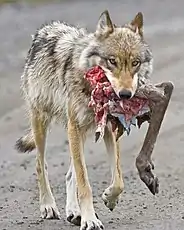
Mostly isolated by the Cordilleran and Laurentide ice sheets, Beringia is considered ecologically separate to the rest of North America, being largely an extension of the Eurasian mammoth steppe.[171] However, the occasional opening of an ice-free corridor, and the migration barrier of the Beringian gap, meant that Eastern Beringia (Alaska and the Yukon) supported a unique assemblage of fauna, with many endemic North American fauna flourishing.[172] This mostly open and treeless steppe-tundra, dominated by grasses, sedges, Artemisia spp., and a range of other forbs had a cold, dry climate, which prevented glaciation. Currently, all specimens of A. simus in Beringia have been dated to a 27,000 year window (50,000 BP~23,000 BP) from Eastern Beringia.[92][63] However, additional undated remains may be of Sangamonian age.[173] The largest known skull of A. simus was recovered from the Yukon, and may represent the largest specimen known.[40][174]
The North Slope of Alaska <40,000 BP (Ikpikpuk and Titaluk rivers) preserves an upland and floodplain environment, with horses, bison then caribou being the most populous herbivores, and woolly mammoths, muskox, elk and saiga antelope more scarce. Cave lions, bears (Ursus arctos and Arctodus simus), and Beringian wolves made up the megafaunal predator guild.[175][176] Isotope data implies that caribou and muskox were principal components of the carnivorous portion of Arctodus simus' Arctic diet, suggesting that the warmer, wetter vegetation on the margins of the dry mammoth steppe (similar to the moist acidic tundra vegetation which dominates today) was the preferred habitat of Arctodus in Beringia.[87][175]
Additionally, upon the flooding of the Bering Strait and expansion of moist tundra and peatlands in Eastern Beringia during MIS-3, lions, brown bears and Homotherium went regionally extinct ~35,000 BP, whereas wolves and Arctodus persisted. Simultaneously, most megafaunal herbivores in Beringia experienced population bottlenecks, whilst mammoth populations steadily declined. This restriction of prey and habitat could explain the extinctions. However, genetically distinct cave lions and brown bears appear in MIS-2 circa the extinction of Arctodus in a re-emerged Beringia ~23,000 BP, opening up the possibility that some level of competition was at play.[92][87][100][101][177] The idea that Arctodus had a kleptoparasitic relationship with wolves and Homotherium in Beringia has been explored,[87] with the additional possibility that Arctodus successfully competed against brown bears and Homotherium for access to caribou pre-LGM.[178]
The local extinction of Arctodus in Beringia ~23,000 BP (possibly due to sharp climatic cooling associated with Heinrich Event-2),[92][63] was much earlier than in other parts of its range. While recolonized by cave lions and brown bears, Arctodus did not repopulate Beringia once the ice-free corridor to the south re-opened later in the Pleistocene.[92][179]
Diet
Herbivory

The fact that Arctodus did not significantly differ in dentition or build from modern bears has led most authors to support the hypothesis that the A. simus was omnivorous, like most modern bears, and would have eaten significant amounts of plant matter.[65][180] Morphologically, Arctodus simus exhibits masticular and dental characteristics which confirms that short-faced bears such as the spectacled bear and Arctodus were adapted to and actively consumed vegetation.[23][50][60][65][61] This is affirmed by a lack of dental damage associated with carnivory amongst specimens of Arctodus.[181] Dental pathologies which have been found, such as incisor wear & supragingival dental calculus in a young individual from Missouri,[45] and cavities associated with carbohydrate consumption in individuals from La Brea, further suggest an omnivorous diet for Arctodus simus.[91][181] Additional morphological adaptations include dexterous forelimbs and a partial false thumb, which would have assisted in foraging for vegetation,[70][75] along with the body size of large Arctodus simus possibly exceeding the expected upper limitations for a Quaternary terrestrial carnivore (based on the more restrictive energy base for a carnivorous diet).[23]
While features of Arctodus simus morphology suggest herbivory, their close phylogenetic relationship to the omni-herbivorous spectacled bear presents the possibility that these traits may be an ancestral condition of the group. A browsing diet foraged from the canopies of trees and shrubs could have been difficult with the large and flattened rostrum and incisor build of Arctodus, with an absence of digging adaptations in their forelimbs and claws limiting rooting.[36][40] Regardless, gross tooth wear suggests consumption of plant matter in the diet of Arctodus simus. The diet of individuals from La Brea was likely more specialized and relied on softer yet tougher foods than omni-herbivorous black bears, with Arctodus' tooth wear remaining consistent throughout the Pleistocene.[60] However, comparisons with the dental microwear of Ursus speleaus suggest dietary differences between the species, with cave bears consuming tougher vegetation than A. simus.[180] Although some researchers argue that herbivory should be more obvious from the isotope data gathered from northern Arctodus,[52] several Arctodus coprolites from The Mammoth Site in South Dakota and Meander Cave at Ni'iinlii'njik Territorial Park, Yukon, contain Juniperus seeds (toxic to ursine bears).[58][182]
Opportunistic carnivory
Evidence suggests that Arctodus also consumed meat, as evidenced by elevated nitrogen-15 isotope levels (corresponding to protein consumption) and bone damage on contemporary fauna. However, even the isotope data of the most carnivorous Beringian Arctodus overlapped with modern, omni-herbivorous brown bears from Europe, eastern Wyoming, and central Montana, demonstrating that isotope data cannot distinguish between hypercarnivores and omnivores which eat a significant amount of animal matter.[40] Additionally, nitrogen-15 is also accumulated in nutritionally stressed herbivores.[183] Elevated carbon-13 levels from all localities (Alaska,[87] California,[25][88] San Luis Potosí,[26] Texas,[89] Vancouver Island,[86][99] and the Yukon)[178] largely suggest browsers and browsed vegetation were the core of A. simus' diet.[37]
Arctodus simus' status as a predator is questioned by its gracility and lack of agility, which could have complicated predation upon adult mega-herbivores, and hindered the chasing down of nimbler prey.[68][69] Nevertheless, larger (male) Arctodus simus are suggested to have been more carnivorous than females, as very large brown bears may not be able to sustain themselves on a vegetarian diet.[99] Studies establish that A. simus would have had a varied diet across its range,[60] with increased competition leading to more herbivory.[91][99] The extinction of cursorial, hyper-carnivorous Borophagus and Huracan ('Agriotherium') in the more open western North America left a vacant niche, possibly contributing to the evolution of A. simus (along with changes to the herbivore guild).[48][51]

Carbon isotope studies
Evidence from the carbon isotope values of an Arctodus simus specimen from Cedral, San Luis Potosí, México, showed that this individual fed upon C3 resources. In fact, that Arctodus individual had the strongest δ13C value of its local fauna. Owing to having only one sample of Arctodus simus from Cedral and the lack of nitrogen isotopic values, the study found it difficult to infer whether Arctodus simus was consuming animal protein. Arctodus' carbon isotope value did not overlap with, but was closest to values from the tapir and Hemiauchenia.[26]
For specimens from inland California (Fairmead Landfill) from the Middle Pleistocene, a 2012 study proposed that Arctodus simus consumed Colombian mammoth, and large ungulates.[185] However, the author republished in 2015 with colleagues, recalculating Arctodus' δ13C values to be closest to C3 vegetation consuming Cervus and Mammut, although again no nitrogen isotope values were recovered.[25] In the later Californian McKittrick Tar Pits, Arctodus simus had a diet which likely included deer and tapir, similar to the one inferred for the Cedral individual.[26]
Alaskan specimens were thought to also largely predate upon similar megafauna as proposed for the Fairmead individuals in the 2012 study,[67] but nitrogen & carbon isotope data suggests reindeer, muskox and possibly fellow predators and their kills, were regularly consumed.[87] Arctodus' nitrogen-15 levels are higher in the Yukon, suggesting that Arctodus possibly occupied an even higher trophic level than other Arctodus in Beringia. However, this contrast likely reflects subtle differences in the isotopic composition of primary producers in the region.[54][186] A specimen from Cowichan Head, Vancouver Island, had isotopes suggesting a terrestrial diet at a relatively high trophic level, aligning with Beringian specimens.[86]
A single find from the Channel Islands of California with nitrogen isotope signatures indicating a ~19% consumption rate of seals (along with bison and camels) bolsters the suggestion that A. simus would have had a flexible diet across its range. The Arctodus fossil in the Channel Islands was likely transported post-mortem from the mainland; the partial reliance on marine resources has been suggested to be as a result of a competitive carnivore guild in mainland California. The marine signal was in between island foxes and bald eagles, most closely resembling Late Pleistocene California condors.[88] A specimen from Friesenhahn Cave, Texas, had a nitrogen-15 sample closest to striped skunks.[89]
Bone damage
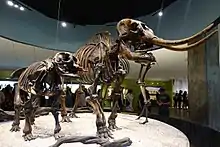
The bite marks found on many bones of ground sloths (Northrotheriops texanus) and young proboscideans at Leisey Shell Pit in Florida matched the size of the canine teeth of Arctodus pristinus. It is not known if these bite marks are the result of active predation or scavenging.[1]
Arctodus simus has been found in association with proboscidean remains near Frankstown, Pennsylvania (juvenile mastodon), and at The Mammoth Site, South Dakota (Columbian mammoths). However, questions remain as to whether these finds determine a predatory or scavenging relationship, or whether they were simply preserved at the same deposit (possibly at different times).[58][163] On the other hand, a woolly mammoth specimen from Saltville, Virginia was likely scavenged on by Arctodus simus, as evidenced by a canine gouge through the calcaneus.[52] Several Columbian mammoth bones from a cave near Huntington Reservoir, Utah also record ursid gnaw marks attributed to Arctodus, with an Arctodus specimen preserved in association with the remains.[56] A mastodon humerus from the Snowmastodon site in Colorado bears tooth marks also suggested to be from Arctodus.
Importantly, the canines of Panthera atrox overlap in size with Arctodus simus, complicating the identification of tooth marks.[52] However, this is not to discredit all tooth marks attributed to Arctodus, as damaged bones from an Arctodus den site in Alaska suggest that Arctodus transported megafaunal longbones back to a cave-like den and chewed on them,[187] at a time when lions had a limited overlap with Arctodus in Beringia.[92][91] Furthermore, a perforated peccary ilium from Sheriden Cave has also been hypothesized as being scavenged by Arctodus simus.[153] Bone damage on a cranial fragment (and possibly the humerus) of an Arctodus individual on Vancouver Island has been attributed to cannibalism, as Arctodus may have been the only large terrestrial carnivoran in the area.[63][99]
Beringia
Analysis of bones from Alaska showed high concentrations of nitrogen-15, a stable nitrogen isotope accumulated by carnivores. Although few specimens exist, there is currently no evidence of the same carbohydrate-related dental pathologies evident in southern populations of Arctodus simus.[91] Based on this evidence, A. simus was suggested to have been more carnivorous in Beringia than the rest of North America (with a preference for herbivores which consumed C3 vegetation, particularly caribou).[87][178] Increased carnivory may be due to a lower proportion of competitors and probably a lower availability of carbohydrate-rich food supplies across the year in the far northern latitudes.[91]
A 2015 study suggests that caribou could not account for the high levels of carbon-13 and nitrogen-15 in some Arctodus individuals in Beringia. The study suggests that the consumption of tundra muskox, which sometimes express high proportions of these isotopes, and possibly other predators in its Beringian range, may explain the data.[87]
It would be reasonable to assume that meat and bone marrow were likely to be the primary food resources for some northern populations of A. simus, in which the survival during the cold season could have depended on the regular scavenging of ungulate carcasses, as is the case with Alaskan brown bears.[37] Ultimately, an opportunistic foraging strategy including up to 50% vegetation, and the meat of reindeer, muskox, carrion, and possibly some predators, is consistent with the isotopic data and the conclusions of the ecomorphological studies.[87]
History of research
"Super predator" hypothesis
.jpg.webp)
One past proposal envisaged A. simus as a brutish predator that overwhelmed the very large but slow megafauna with its great physical strength.[68] However, despite being very large, its limbs were too gracile for such an attack strategy,[68][69] significantly more gracile so than Arctotherium angustidens at that.[39]
Due to their long legs, an alternative hypothesis suggested by Björn Kurtén is that it may have hunted by running down Pleistocene herbivores such as wild horses and saiga antelopes, an idea that at one time earned it the name "running bear".[36][37][95] However, during pursuit of speedy game animals, the bear's sheer physical mass, inflexible spine and plantigrade gait would be a handicap; modern brown bears can run at the same speed but quickly tire and cannot keep up a chase for long. Correspondingly, although a 700 kg Arctodus may have been able to reach a maximum speed of 51 kilometres per hour (32 mph), all modern bears have maximum speeds significantly lower than mass-based calculations for speed. As a result, paleontologist Paul Matheus suggests that Arctodus' top speed was 40–45 km/h (25–28 mph). Arctodus skeletons do not articulate in a way that would have allowed for quick turns – an ability required of any predator that survives by chasing down agile prey.[33][40][68] Proportionally taller legs, a short trunk, proximally elongated limbs, a stride which had little to no unsupported intervals, and proportionally small and laterally-orientated eyes, further complicated ambush hunting as a lifestyle for Arctodus.[23][40][51]
Furthermore, the lack of definitive predatory adaptions (such as the absence of laterally compressed canines, and carnassials built for crushing and grinding rather than shearing meat) puts doubt to any species-wide hyper-carnivorous interpretations of Arctodus.[37][70][40][65] The anatomical requirements for a large, cursorial, hyper-carnivorous bear, are present in Huracan and Agriotherium, but not Arctodus.[51][188] Adaptations for predatory behavior are highly divergent in ursids versus other carnivorans, with features such as a short rostrum and long carnassials not being indicative of a predatory lifestyle in Arctodus.[65] Although the only living hyper-carnivorous ursid, the polar bear, also lacks carnassial shears, the species' specialization on small prey and reliance on blubber (rather than coarser flesh) invalidates a comparison with Arctodus.[23][40][65] Therefore, carnivory was limited to the regular scavenging of carcasses and opportunistic hunting, as is the case with the modern brown bear.[36][37]
Specialist kleptoparasite vs Omnivore
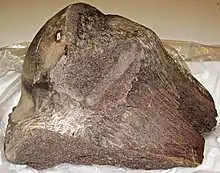
The idea that Arctodus was a kleptoparasite was most notably proposed by Paul Matheus.[33] Under this model, A. simus was ill-equipped to be an active predator, having evolved as a specialized scavenger adapted to cover an extremely large home range in order to seek out broadly and unevenly distributed mega-mammal carcasses.[40] There would have been additional selective pressure for increased body size, so that Arctodus could procure and defend carcasses from other large carnivores, some of which were gregarious, or chase them from their kills and steal their food.[68] Matheus calculated that with a hyper-carnivorous diet, a 700 kg (1,500 lb) Beringian Arctodus would need to consume ~5,853 kilograms (12,904 lb) of meat per year- the equivalent of 12 bison, 44.6 horses, or 2 woolly mammoths (adjusted for the non-edible portions of the body). Therefore, Arctodus would have had to obtain 100 kg (220 lb) of flesh/edible carrion every 6.25 days (16 kg (35.3 lb) per day).[33][67][189]
Furthermore, the short rostrum, resulting in increased out-forces of the jaw-closing muscles (temporalis and masseter), may have been an adaptation for cracking bones with their broad carnassials. Such use of the P4 and m1 teeth is supported by the heavy wear on these teeth in old individuals of Arctodus simus and Agriotherium (another giant bear).[40] Additionally, strengthened tooth enamel in Arctodus may have evolved to crack bone,[64] with a low jaw condyle potentially leading to a wide gape.[31][62][63] Moreover, at least in Beringia, the conservative growth strategies, long lives and low natural mortality rates of horses and mammoths should have provided somewhat evenly distributed carcasses throughout the year (unlike ruminants such as bison, whose mortality peaks in late winter to early spring).[67] Finally, that Arctodus and the cave hyena did not spread into Siberia and North America respectively suggests some form of competitive exclusion was at play (although many other fauna did not cross the Beringian gap, such as ground sloths and the woolly rhino).[58][190][191]
Rebuttal
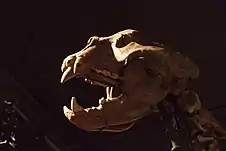
The kleptoparasite hypothesis has been repeatedly challenged. The short, broad rostrum of Arctodus is a characteristic also shared with the sun bear and the spectacled bear, which are both omnivorous.[37] Specialized scavengers like hyenas show distinctive patterns of molar damage from cracking bones. Based on lack of "bone-cracking" wear in specimens from Rancho La Brea, researchers in 2013 concluded that Arctodus simus was not a specialized scavenger. Of living bears, this population of A. simus showed the most similar tooth wear patterns to its closest living relative, the spectacled bear, which can have a highly varied diet ranging between omnivory to almost pure herbivory.[23][60]
Additionally, severe tooth crown fractures and alveolar infections were found in the South American giant short-faced bear (Arctotherium angustidens). These were interpreted as evidence of feeding on hard materials (e.g. bones), which could tentatively indicate for these bears the regular scavenging of ungulate carcasses obtained through kleptoparasitism. However, such dental pathologies were not observed in various specimens of A. simus, other than the strong wear facets of old individuals.[37] Instead, recovered dental damage (incisor wear, dental calculus & cavities) is herbivorous in origin.[45][91] Moreover, researchers in 2015 reviewing links between canine breakage, microwear texture patterns and carnivorans from La Brea found that A. simus consumed foods softer and tougher than black bears and polar bears, avoided hard/brittle foods, and reaffirmed affinities between A. simus and modern, largely herbivorous spectacled bears.[181]
Furthermore, the relative lack of Arctodus remains at predator traps such as the La Brea Tar Pits, suggests that Arctodus did not compete for carcasses.[91] Although La Brea has produced more Arctodus simus specimens than any other site (presumably due to the quality of preservation with tar), they are only 1% of all carnivorans in the pits,[181] which is a similar rate to brown bears and black bears, both omnivorous ursids which lean towards herbivory.[192] A similar rate (~0.9%) of relative abundance was calculated for Arctodus compared to other megafauna at the Natural Trap Cave in Wyoming by 1993.[193] Additionally, isotope analyses of Beringian Arctodus specimens suggest that Arctodus had a low consumption rate of horses and mammoths in Beringia, despite those species making up ~50% of the available biomass in Beringia.[87] Further evidence comes from the evolution of brain size relative to body size- bears with high caloric diets and which do not exhibit dormancy showed a weak but significant correlation with bigger relative brain size. Arctodus simus plotted in between the likely hypercarnivorous Cephalogale, and the almost exclusively herbivorous Eurasian cave bear and Indarctos, suggesting omnivory.[194]
Relationship with humans
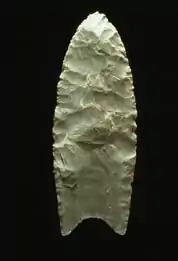
One documented interaction with Clovis people is present at the Lubbock Lake Landmark, Texas. A likely already deceased Arctodus simus was processed for subsistence (butchery marks indicated skinning, de-fleshing and disarticulation) and tool production, much in the same way as a mammoth carcass (~13,000 BP / 11,100 14C BP ).[195][196] Additionally, other remains of the Arctodus simus have been found in association with Paleo-Indian artifacts in Sheriden Cave, Ohio,[152][153][197] and Huntington Dam, Utah,[56] with an A. simus footbone fragment from Spalding, Idaho also being charred.[198] The direct relationship between humans and some associated Arctodus remains has been debated.[199][200]
Human hunting and butchery of large megafauna, particularly mammoths and mastodon, would likely have put people in competition with Arctodus simus. Defense against these large bears as well as the abandonment of carcasses are plausible outcomes.[63]
Migration barrier hypothesis
In the late 1980s, Val Geist hypothesized that humans, along with other Siberian megafauna such as moose and brown bears, to have found Arctodus, along with other "specialist, aggressive, competitive Rancholabrean fauna" a barrier to migrating into North America (both Beringia and below the ice sheets). Male A. simus were the largest and most powerful carnivorous land mammals in North America, with the potential specialization in obtaining and dominating distant and scarce resources. Humans in this hypothesis, though familiar with brown bears, would not have been able to effectively contend with the Arctodus simus and other large Pleistocene carnivores, a situation that would have suppressed human population expansion.[63][67] However, modern research disagrees with this hypothesis,[201] and establishes an extended co-existence of humans and Arctodus across North America.[202]
Beringia
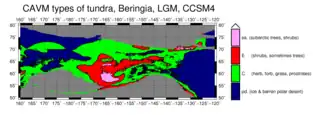
Humans migrated to North America via the Siberian mammoth steppe, arriving at Eastern Beringia (Alaska and the Yukon). However, the migration was halted at the North American Ice Sheet, which separated Beringia and southern North America for most of the Late Pleistocene.[203] Both humans and Arctodus are first dated to ~50,000 BP in Beringia, both from sites in the Yukon, and co-existed until Arctodus went extinct in Beringia ~23,000 BP during the Last Glacial Maximum. This co-existence continued through the regional extinction of other Beringian predators such as lions, brown bears and saber-tooth cats.[92] Important sites of pre-LGM human occupation in Beringia include Old Crow Flats & the Klondike,[204][205] Kuparuk River Valley,[206] & the Bluefish Caves.[207][208]
Contiguous North America
The human colonization of North America south of the ice sheets further disproves the idea that Arctodus was a migration barrier. Pre-LGM sites across the Americas such as Chiquihuite Cave, Valsequillo, El Cedral, Santa Elina, Calico, Hartley Mammoth Site, and Pendejo Cave suggest that humans co-existed with Arctodus for many thousands, if not tens of thousands of years. This extensive overlap with Arctodus across North America puts significant doubt to the migration barrier hypothesis.[209][210][211][212][213]
The earliest universally accepted pre-Clovis site south of Beringia are the White Sands footprints in New Mexico, dated to ~22,000 BP. Younger dates from Saltville, La Sena, Meadowcroft, Topper, Triquet Island, Cactus Hill, and Buttermilk Creek in the USA, and Monte Verde in Chile, further solidify a rapid human expansion across the Americas despite competitive pressure from North America's predators.[63][202]
Extinction
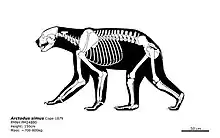
After the extinction of Arctodus pristinus in the late Irvingtonian (300,000 years ago), Arctodus simus was the final representative of the genus.[18] Arctodus simus went extinct around 12,800 years ago, which is relatively late when compared to other North American victims of the Quaternary extinction event, having reached the Pleistocene-Holocene boundary (13,800 BP - 11,400 BP).[115][214] Both local and regionalized dietary flexibility has been a factor suggested for the species' longevity.[91]
Various factors, including the depletion in number of large herbivores,[41][36] the diminishing nutritional quality of plants during climate change, and competition with fellow omnivores (humans and brown bears) for food resources, have been suggested as the cause of Arctodus simus' extinction.[195] However, multiple studies put doubt on brown bears being culpable in Arctodus simus' extinction, with the brown bear being more of an ecological replacement that was more adaptable to change.[28][63][36] Moreover, there is no strong evidence that humans hunted large extinct Pleistocene carnivores in North America, and no clear indication of direct human involvement in the extinction of Arctodus simus.[63] Additionally, dental wear evidence from Rancho La Brea does not suggest that food shortages were to blame for the demise of Arctodus simus, or other large bodied carnivorans.[60]
Climate change
Of the factors discussed, vegetation shifts in the latest Pleistocene may have been particularly unfavorable for Arctodus simus, due to a reduction of quality foraging for subsistence. For example, on Vancouver Island (~13,500 BP), vegetation changed rapidly from open woodlands with abundant lodgepole pine to increasingly closed forests with shade-tolerant spruce, mountain hemlock, and red alder. These changes, effective by ~12,450 BP, point toward cool and moist conditions during the Younger Dryas stadial. Closed forests continued to expand in the early Holocene. Even though Arctodus simus was not restricted to open areas and could inhabit in different environments, the timing of the regional shift from an open pine woodland habitat to a densely forested vegetation implies that these vegetation changes contributed to the local extinction of Arctodus simus, along with many other megafauna.[63]
Low genetic diversity
.jpg.webp)
Arctodus simus had a very low level of genetic diversity from most sampled specimens, albeit a sample with a Beringian and temporal bias (<44,000 BP). A loss and/or replacement of mitochondrial DNA lineages before the Last Glacial Maximum, and decrease in population size from a previously genetically diverse population, has been noted in a variety of Eurasian and American Late Pleistocene megafauna.[76][215] That the individual from Sheriden Cave, Ohio was very closely related to Beringian specimens may further support this idea, as these populations had possibly been isolated from before the Last Glacial Maximum (tens of thousands of years).[76]
A lack of genetic diversity has been attributed to a reduced ability to adapt to environmental conditions. Small population sizes may be characteristic of tremarctine bears- the spectacled bear, while having low levels of genetic diversity, has no signs of a recent genetic bottleneck. However, brown bears had diverse, sympatric source populations in Eurasia, allowing for repopulations/reinvasions into the Americas. If Arctodus simus experienced genetic bottlenecks or local extinctions prior to the Last Glacial Maximum, Arctodus would have been unable to supplement their reduced genetic diversity with new migrants like the brown bear could, making them vulnerable to extinction.[76]
Last dates
The youngest date for Arctodus simus is circa 12,700 BP from Friesenhahn Cave, Texas, calibrated from 10,814 ± 55 radiocarbon years (14C BP). However, this date should be viewed with caution, as analyses suggest the collagen protein was degraded. A vertebra from Bonner Springs, Kansas, was dated to ca. 12,800 BP (based on 10,921 ± 50 radiocarbon years) from well preserved collagen. However, another radiocarbon date from a different laboratory on the same vertebra widens the possible age of the vertebra to between 9,510 and 11,021 14C BP (at 2σ). Nevertheless, a specimen from Huntington Dam, Utah was also dated to ca. 12,800 BP from two radiocarbon dates (10,870 ± 75 & 10,976 ± 40 14C BP) and is therefore considered reliable.[47][115]
See also
References
- 1 2 3 4 5 6 "Arctodus pristinus". Florida Museum. 2017-03-30. Retrieved 2022-02-21.
- 1 2 3 4 5 6 7 8 9 10 11 12 13 14 15 Emslie, Steven D. (1995). "The fossil record of Arctodus pristinus (Ursidae: Tremarctinae) in Florida" (PDF). Bulletin of the Florida Museum of Natural History. 37: 501–514. S2CID 168164209.
- ↑ "South Carolina Fossils". Nature. 20 (510): 354–355. 1879-08-01. Bibcode:1879Natur..20..354.. doi:10.1038/020354a0. ISSN 1476-4687. S2CID 4034608.
- 1 2 Cope E. D. (1879). "The cave bear of California". American Naturalist. 13: 791.
- 1 2 3 Feranec, Robert S. (November 2009). "Implications of Radiocarbon Dates from Potter Creek Cave, Shasta County, California, USA". Radiocarbon. 51 (3): 931–936. Bibcode:2009Radcb..51..931F. doi:10.1017/S0033822200034007. S2CID 131722109.
- ↑ Merriam, John C.; Stock, Chester (1925), Relationships and Structure of the Short-Faced Bear, Arctotherium, from the Pleistocene of California, Washington, DC: Carnegie institution of Washington, pp. 1–25, retrieved 2022-05-06
- 1 2 3 4 5 6 7 8 9 10 11 12 13 14 15 16 17 18 19 20 21 22 23 24 Richards, Ronald L.; Churcher, C.S.; Turnbull, William D. (1996-12-31), "Distribution and size variation in North American Short-faced bears, Arctodus simus", Palaeoecology and Palaeoenvironments of Late Cenozoic Mammals, University of Toronto Press, pp. 191–246, doi:10.3138/9781487574154-012, ISBN 978-1-4875-7415-4, retrieved 2023-11-15
- ↑ "Arctodus". www.utep.edu. Retrieved 2022-05-05.
- ↑ Spamer, Earle E.; Daeschler, Edward; Philadelphia, Academy of Natural Sciences of; Vostreys-Shapiro, L. Gay (1995). A Study of Fossil Vertebrate Types in the Academy of Natural Sciences of Philadelphia: Taxonomic, Systematic, and Historical Perspectives. Academy of Natural Sciences. ISBN 978-0-910006-51-4.
- ↑ Hay, Oliver Perry (1901). Bibliography and Catalogue of the Fossil Vertebrata of North America. U.S. Government Printing Office.
- ↑ Merriam, John C.; Stock, Chester (1925), Relationships and Structure of the Short-Faced Bear, Arctotherium, from the Pleistocene of California, Washington, DC: Carnegie institution of Washington, pp. 1–25, retrieved 2022-06-09
- ↑ Kurtén, Björn (June 1, 1963). "Fossil Bears from Texas" (PDF). The Pearce-Sellards Series. 1 – via Texas Memorial Museum, University of Texas.
- 1 2 Ferrusquía-Villafranca, Ismael; Arroyo-Cabrales, Joaquín; Martínez-Hernández, Enrique; Gama-Castro, Jorge; Ruiz-González, José; Polaco, Oscar J.; Johnson, Eileen (2010-04-15). "Pleistocene mammals of Mexico: A critical review of regional chronofaunas, climate change response and biogeographic provinciality". Quaternary International. Faunal Dynamics and Extinction in the Quaternary: Studies in Honor of Ernest L. Lundelius, Jr. 217 (1): 53–104. Bibcode:2010QuInt.217...53F. doi:10.1016/j.quaint.2009.11.036. ISSN 1040-6182.
- ↑ Arroyo-Cabrales, Joaquín; Polaco, Oscar J.; Johnson, Eileen; Ferrusquía-Villafranca, Ismael (2010-02-01). "A perspective on mammal biodiversity and zoogeography in the Late Pleistocene of México". Quaternary International. Quaternary Changes of Mammalian Communities Across and Between Continents. 212 (2): 187–197. Bibcode:2010QuInt.212..187A. doi:10.1016/j.quaint.2009.05.012. ISSN 1040-6182.
- ↑ Schubert, Blaine W.; Chatters, James C.; Arroyo-Cabrales, Joaquin; Samuels, Joshua X.; Soibelzon, Leopoldo H.; Prevosti, Francisco J.; Widga, Christopher; Nava, Alberto; Rissolo, Dominique; Erreguerena, Pilar Luna (May 2019). "Yucatán carnivorans shed light on the Great American Biotic Interchange". Biology Letters. 15 (5): 20190148. doi:10.1098/rsbl.2019.0148. PMC 6548739. PMID 31039726.
- 1 2 3 4 5 6 7 8 9 10 11 Pedersen, Mikkel Winther; De Sanctis, Bianca; Saremi, Nedda F.; Sikora, Martin; Puckett, Emily E.; Gu, Zhenquan; Moon, Katherine L.; Kapp, Joshua D.; Vinner, Lasse; Vardanyan, Zaruhi; Ardelean, Ciprian F. (2021-06-21). "Environmental genomics of Late Pleistocene black bears and giant short-faced bears". Current Biology. 31 (12): 2728–2736.e8. doi:10.1016/j.cub.2021.04.027. hdl:10037/22808. PMID 33878301. S2CID 233303447.
- ↑ Soibelzon, Leopoldo H.; Romero, M.R. Aguilar (2008-10-14). "A Blancan (Pliocene) short-faced bear from El Salvador and its implications for Tremarctines in South America". Neues Jahrbuch für Geologie und Paläontologie - Abhandlungen. 250 (1): 1–8. doi:10.1127/0077-7749/2008/0250-0001.
- 1 2 3 4 5 6 7 8 9 10 11 12 13 14 15 16 Schubert, Blaine; Hulbert, Richard; MacFadden, Bruce; Searle, Michael; Searle, Seina (2010-01-01). "Giant Short-faced Bears (Arctodus simus) in Pleistocene Florida USA, a Substantial Range Extension". Journal of Paleontology. 84 (1): 79–87. Bibcode:2010JPal...84...79S. doi:10.1666/09-113.1. S2CID 131532424.
- ↑ Krause, Johannes; Unger, Tina; Noçon, Aline; Malaspinas, Anna-Sapfo; Kolokotronis, Sergios-Orestis; Stiller, Mathias; Soibelzon, Leopoldo; Spriggs, Helen; Dear, Paul H; Briggs, Adrian W; Bray, Sarah CE; O'Brien, Stephen J; Rabeder, Gernot; Matheus, Paul; Cooper, Alan (December 2008). "Mitochondrial genomes reveal an explosive radiation of extinct and extant bears near the Miocene-Pliocene boundary". BMC Evolutionary Biology. 8 (1): 220. doi:10.1186/1471-2148-8-220. ISSN 1471-2148. PMC 2518930. PMID 18662376.
- ↑ Bell, Christopher; Lundelius, Ernest L.; Barnosky, Anthony D.; Zarzewski, Richard J.; Graham, Russell; Lindsay, Everett H.; Ruez, Dennis R.; Semken, Holmes A.; Webb, S. David (2004-04-21). "Chapter 7: The Blancan, Irvingtonian, and Rancholabrean Mammal Ages". In Woodburne, Michael O. (ed.). Late Cretaceous and Cenozoic Mammals of North America. Columbia University Press. doi:10.7312/wood13040. ISBN 978-0-231-50378-5.
- ↑ Brown, Gary (1996). Great Bear Almanac. Lyons & Burford. p. 340. ISBN 978-1-55821-474-3.
- 1 2 3 Russell, Dale A.; Rich, Fredrick J.; Schneider, Vincent; Lynch-Stieglitz, Jean (May 2009). "A warm thermal enclave in the Late Pleistocene of the South-eastern United States". Biological Reviews. 84 (2): 173–202. doi:10.1111/j.1469-185X.2008.00069.x. PMID 19391200. S2CID 9609391.
- 1 2 3 4 5 6 7 8 9 10 11 12 13 14 15 Emslie, Steven D.; Czaplewski, Nicholas J. (1985-11-15). "A new record of giant short-faced bear, Arctodus simus, from western North America with a re-evaluation of its paleobiology". Contributions in Science. 371: 1–12. doi:10.5962/p.226835. S2CID 133986793.
- 1 2 3 Martin, Larry; Neuner, A. (1978-01-01). "The End of the Pleistocene in North America". Transactions of the Nebraska Academy of Sciences and Affiliated Societies.
- 1 2 3 4 5 6 7 Trayler, Robin B.; Dundas, Robert G.; Fox-Dobbs, Kena; Van De Water, Peter K. (2015-11-01). "Inland California during the Pleistocene—Megafaunal stable isotope records reveal new paleoecological and paleoenvironmental insights". Palaeogeography, Palaeoclimatology, Palaeoecology. 437: 132–140. Bibcode:2015PPP...437..132T. doi:10.1016/j.palaeo.2015.07.034. ISSN 0031-0182.
- 1 2 3 4 5 6 7 8 Pérez-Crespo, Víctor Adrián; Arroyo-Cabrales, Joaquín; Morales-Puente, Pedro; Cienfuegos-Alvarado, Edith; Otero, Francisco J. (March 2018). "Diet and habitat of mesomammals and megamammals from Cedral, San Luis Potosí, México". Geological Magazine. 155 (3): 674–684. Bibcode:2018GeoM..155..674P. doi:10.1017/S0016756816000935. S2CID 132502543.
- 1 2 Harris, Arthur H. (November 1985). "Preliminary report on the vertebrate fauna of U-Bar Gave, Hidalgo County, New Mexico" (PDF). New Mexico Geology. 7 (4): 74–84. doi:10.58799/NMG-v7n4.74. S2CID 237056633.
- 1 2 3 4 5 6 7 8 9 10 11 12 13 Esker, Donald; Wilkins, William; Agenbroad, Larry (2010-08-13). "Esker, Wilkins, and Agenbroad—Multivariate Analysis Of Ursids: A multivariate analysis of the ecology of North American Pleistocene bears, with a focus on Arctodus simus". ResearchGate.
- 1 2 3 Scott, Eric; Cox, Shelley M. (May 24, 1993). "Arctodus simus (Cope, 1879) from Riverside County, California" (PDF). PaleoBios. 15 (2): 27–36.
- 1 2 Hill, Christopher L.; Wilson, Mike C. (2000). "The Doeden Local Fauna (Illinoian/Sangamonian?), Eastern Montana". Unknown: 140–142 – via ResearchGate.
- 1 2 3 4 5 Kurtén, Björn (1967). Pleistocene Bears of North America: Genus Arctodus, short-faced bears. Societas pro Fauna et Flora Fennica.
- ↑ Van Valkenburgh, Blaire; Hayward, Matthew W.; Ripple, William J.; Meloro, Carlo; Roth, V. Louise (2016-01-26). "The impact of large terrestrial carnivores on Pleistocene ecosystems". Proceedings of the National Academy of Sciences. 113 (4): 862–867. Bibcode:2016PNAS..113..862V. doi:10.1073/pnas.1502554112. ISSN 0027-8424. PMC 4743832. PMID 26504224.
- 1 2 3 4 5 Nancy Sisinyak. "The Biggest Bear ... Ever". Alaska Fish and Wildlife News. Retrieved 2008-01-12.
- 1 2 Fisher, W. A. (2018-02-05). "How Big Was This Short-Faced Bear?". North American Bear Center. Retrieved 2023-11-02.
- 1 2 3 4 5 Richards, Ronald L.; Neiburger, Ellis J.; Turnbull, William D. (1995). Giant short-faced bear (Arctodus simus yukonensis) remains from Fulton County, northern Indiana. Chicago, Ill.: Field Museum of Natural History.
- 1 2 3 4 5 6 7 8 Mattson, David J. (1998). "Diet and Morphology of Extant and Recently Extinct Northern Bears". Ursus. 10: 479–496. JSTOR 3873160.
- 1 2 3 4 5 6 7 8 9 10 11 12 13 14 15 16 17 18 Figueirido; et al. (2010). "Demythologizing Arctodus simus, the 'short-faced' long-legged and predaceous bear that never was". Journal of Vertebrate Paleontology. 30 (1): 262–275. Bibcode:2010JVPal..30..262F. doi:10.1080/02724630903416027. S2CID 85649497.
- 1 2 3 Christiansen, Per (1999). "What size were Arctodus simus and Ursus spelaeus (Carnivora: Ursidae)?". Annales Zoologici Fennici. 36 (2): 93–102. JSTOR 23735739.
- 1 2 3 Soibelzon, Leopoldo H.; Schubert, Blaine W. (2011). "The Largest Known Bear, Arctotherium Angustidens, from the Early Pleistocene Pampean Region of Argentina: With a Discussion of Size and Diet Trends in Bears". Journal of Paleontology. 85 (1): 69–75. doi:10.1666/10-037.1. hdl:11336/104215. JSTOR 23019499. S2CID 129585554.
- 1 2 3 4 5 6 7 8 9 10 11 12 13 14 15 16 Sorkin, B. (January 2006). "Ecomorphology of the giant short-faced bears Agriotherium and Arctodus". Historical Biology. 18 (1): 1–20. doi:10.1080/08912960500476366. S2CID 85301983.
- 1 2 Lambert, W. David; Holling, Crawford S. (1998-03-01). "Original Articles: Causes of Ecosystem Transformation at the End of the Pleistocene: Evidence from Mammal Body-Mass Distributions". Ecosystems. 1 (2): 157–175. doi:10.1007/s100219900012. ISSN 1432-9840. S2CID 29456831.
- 1 2 3 Kurten, B.; Anderson, Elaine (1974). "Association of Ursus arctos and Arctodus simus (Mammalia: Ursidae) in the late Pleistocene of Wyoming". Breviora. 426: 1––6. ISSN 0006-9698.
- ↑ "The California grizzly bear | La Brea Tar Pits". tarpits.org. Retrieved 2022-06-22.
- 1 2 Nelson, Michael E.; Madsen, James H. (1983). "A Giant Short-Faced Bear (Arctodus simus) from the Pleistocene of Northern Utah". Transactions of the Kansas Academy of Science. 86 (1): 1–9. doi:10.2307/3628418. JSTOR 3628418.
- 1 2 3 4 5 6 7 8 Schubert, Blaine; Kaufmann, James (2003-08-01). "A partial short-faced bear skeleton from an Ozark Cave with comments on the paleobiology of the species". Journal of Cave and Karst Studies. 65.
- 1 2 Fowler, Nicholas L.; Spady, Thomas J.; Wang, Guiming; Leopold, Bruce D.; Belant, Jerrold L. (October 2021). "Denning, metabolic suppression, and the realisation of ecological opportunities in Ursidae". Mammal Review. 51 (4): 465–481. doi:10.1111/mam.12246. S2CID 233847639.
- 1 2 3 4 Schubert, Blaine W. (2010-04-15). "Late Quaternary chronology and extinction of North American giant short-faced bears (Arctodus simus)". Quaternary International. Faunal Dynamics and Extinction in the Quaternary: Studies in Honor of Ernest L. Lundelius, Jr. 217 (1): 188–194. Bibcode:2010QuInt.217..188S. doi:10.1016/j.quaint.2009.11.010.
- 1 2 3 Mitchell, Kieren J.; Bray, Sarah C.; Bover, Pere; Soibelzon, Leopoldo; Schubert, Blaine W.; Prevosti, Francisco; Prieto, Alfredo; Martin, Fabiana; Austin, Jeremy J.; Cooper, Alan (2016-04-30). "Ancient mitochondrial DNA reveals convergent evolution of giant short-faced bears (Tremarctinae) in North and South America". Biology Letters. 12 (4): 20160062. doi:10.1098/rsbl.2016.0062. PMC 4881349. PMID 27095265.
- 1 2 Soibelzon, Leopoldo; Tarantini, Viviana Beatriz (January 2009). "Body mass estimation of extinct and extant South American bears (Ursidae, Tremarctinae)". Revista del Museo Argentino de Ciencias Naturales. 11 (2): 243–254. doi:10.22179/REVMACN.11.263 – via ResearchGate.
- 1 2 3 4 5 6 7 FIGUEIRIDO, BORJA; SOIBELZON, LEOPOLDO H. (2009-08-19). "Inferring palaeoecology in extinct tremarctine bears (Carnivora, Ursidae) using geometric morphometrics". Lethaia. 43 (2): 209–222. doi:10.1111/j.1502-3931.2009.00184.x.
- 1 2 3 4 5 6 7 8 9 Jiangzuo, Qigao; Flynn, John J.; Wang, Shiqi; Hou, Sukuan; Deng, Tao (2023-03-14). "New Fossil Giant Panda Relatives (Ailuropodinae, Ursidae): A Basal Lineage of Gigantic Mio-Pliocene Cursorial Carnivores". American Museum Novitates (3996): 1–71. doi:10.1206/3996.1. ISSN 0003-0082. S2CID 257508340.
- 1 2 3 4 5 Schubert, Blaine W.; Wallace, Steven C. (August 2009). "Late Pleistocene giant short-faced bears, mammoths, and large carcass scavenging in the Saltville Valley of Virginia, USA". Boreas. 38 (3): 482–492. Bibcode:2009Borea..38..482S. doi:10.1111/j.1502-3885.2009.00090.x. S2CID 129612660.
- ↑ Stark, Mike (2022). Chasing the Ghost Bear: On the Trail of America's Lost Super Beast. U of Nebraska Press. pp. Fig. 19. ISBN 978-1-4962-2902-1.
- 1 2 3 Matheus, Paul E. (1995-11-01). "Diet and Co-ecology of Pleistocene Short-Faced Bears and Brown Bears in Eastern Beringia". Quaternary Research. 44 (3): 447–453. Bibcode:1995QuRes..44..447M. doi:10.1006/qres.1995.1090. ISSN 0033-5894. S2CID 83542760.
- ↑ Goswami, Anjali; Milne, Nick; Wroe, Stephen (2011-06-22). "Biting through constraints: cranial morphology, disparity and convergence across living and fossil carnivorous mammals". Proceedings of the Royal Society B: Biological Sciences. 278 (1713): 1831–1839. doi:10.1098/rspb.2010.2031. ISSN 0962-8452. PMC 3097826. PMID 21106595.
- 1 2 3 4 Gillette, David D.; Madsen, David B. (1992-03-06). "The short-faced bear Arctodus simus from the late Quaternary in the Wasatch Mountains of central Utah". Journal of Vertebrate Paleontology. 12 (1): 107–112. Bibcode:1992JVPal..12..107G. doi:10.1080/02724634.1992.10011436.
- 1 2 3 Slaughter, B. H.; Crook, W. W. Jr.; Harris, R. K.; Allen, D. C.; Seifert, M. (1962-01-01). The Hill-Shuler Local Faunas of the Upper Trinity River, Dallas and Denton Counties, Texas. The University of Texas at Austin, Bureau of Economic Geology. doi:10.23867/ri0048d.
- 1 2 3 4 Baryshnikov, Gennady (1994). Agenbroad, Larry D.; Mead, Jim I. (eds.). The Hot Springs Mammoth Site: A Decade of Field and Laboratory Research in Paleontology, Geology and Paleoecology. The Mammoth Site of Hot Springs, South Dakota Inc. pp. Chapter 16.
- ↑ Dickinson, Edwin; Elminowski, Erin E.; Flores, Deanna; Eldridge, Emma I.; Granatosky, Michael C.; Hartstone‐Rose, Adam (October 2022). "A morphological analysis of carnivoran ossicles from Rancho La Brea". Journal of Morphology. 283 (10): 1337–1349. doi:10.1002/jmor.21506. ISSN 0362-2525. PMC 9826070. PMID 36041006.
- 1 2 3 4 5 6 7 Donohue, Shelly L.; DeSantis, Larisa R. G.; Schubert, Blaine W.; Ungar, Peter S. (30 October 2013). "Was the giant short-faced bear a hyper-scavenger? A new approach to the dietary study of ursids using dental microwear textures". PLOS ONE. 8 (10): e77531. Bibcode:2013PLoSO...877531D. doi:10.1371/journal.pone.0077531. PMC 3813673. PMID 24204860.
- 1 2 Meloro, Carlo (2011-03-17). "Feeding habits of Plio-Pleistocene large carnivores as revealed by the mandibular geometry". Journal of Vertebrate Paleontology. 31 (2): 428–446. Bibcode:2011JVPal..31..428M. doi:10.1080/02724634.2011.550357. ISSN 0272-4634. S2CID 85255472.
- 1 2 Voorhies, M. R.; Corner, R. G. (1986). "Giant Bear Arctodus as a Potential Breaker and Flaker of Late Pleistocene Megafaunal Remains". Current Research in the Pleistocene. 3: 49–51.
- 1 2 3 4 5 6 7 8 9 10 11 12 13 14 15 16 17 18 19 20 Steffen, Martina L.; Fulton, Tara L. (2018-02-01). "On the association of giant short-faced bear (Arctodus simus) and brown bear (Ursus arctos) in late Pleistocene North America". Geobios. 51 (1): 61–74. Bibcode:2018Geobi..51...61S. doi:10.1016/j.geobios.2017.12.001.
- 1 2 Stefen, Clara (2001). "Enamel Structure of Arctoid Carnivora: Amphicyonidae, Ursidae, Procyonidae, and Mustelidae". Journal of Mammalogy. 82 (2): 450–462. doi:10.1644/1545-1542(2001)082<0450:ESOACA>2.0.CO;2. ISSN 0022-2372. JSTOR 1383726. S2CID 85871953.
- 1 2 3 4 5 6 Figueirido, B.; Palmqvist, P.; Pérez‐Claros, J. A. (2008-12-22). "Ecomorphological correlates of craniodental variation in bears and paleobiological implications for extinct taxa: an approach based on geometric morphometrics". Journal of Zoology. 277 (1): 70–80. doi:10.1111/j.1469-7998.2008.00511.x. ISSN 0952-8369.
- ↑ Richards, Ronald L.; Churcher, C.S.; Turnbull, William D. (1996-12-31), "Distribution and size variation in North American Short-faced bears, Arctodus simus", Palaeoecology and Palaeoenvironments of Late Cenozoic Mammals, University of Toronto Press, pp. 191–246, doi:10.3138/9781487574154-012, ISBN 978-1-4875-7415-4, retrieved 2023-11-15
- 1 2 3 4 5 6 7 8 Matheus, Paul Edward (1997). Paleoecology and ecomorphology of the giant short-faced bear in Eastern Beringia (PhD thesis).
- 1 2 3 4 5 6 7 8 Matheus, Paul E. (2003). Locomotor adaptations and ecomorphology of short-faced bears (Arctodus simus) in eastern Beringia. Yukon Palaeontologist, Gov't. of Yukon. OCLC 243520303.
- 1 2 3 Lynch, Eric Randally (2012-08-06). Cursorial Adaptations in the Forelimb of the Giant Short-Faced Bear, Arctodus simus, Revealed by Traditional and 3D Landmark Morphometrics. East Tennessee State University. OCLC 818344518.
- 1 2 3 Meloro, Carlo; de Oliveira, Alessandro Marques (2019-03-01). "Elbow Joint Geometry in Bears (Ursidae, Carnivora): a Tool to Infer Paleobiology and Functional Adaptations of Quaternary Fossils" (PDF). Journal of Mammalian Evolution. 26 (1): 133–146. doi:10.1007/s10914-017-9413-x. S2CID 25839635.
- ↑ Weems, Robert E. (2018). "An Early Pleistocene (Early Irvingtonian) Footprint Fauna from the Bacons Castle Formation, Westmoreland Formation, Virginia". New Mexico Museum of Natural History and Science Bulletin. 79: 731–748 – via ResearchGate.
- ↑ Packard, E.L.; Allison, I.S.; Cressman, L.S. "Mammalian Tracks in the Late Pliocene or Early Pleistocene Beds of Lake County Oregon" (PDF). Oregon Geology. Retrieved June 11, 2017.
- 1 2 Lucas, Spencer G.; Spielmann, Justin A.; Lockley, Martin G. (2007). "Cenozoic Vertebrate Tracks and Traces". New Mexico Museum of Natural History and Science Bulletin. 42.
- ↑ Rovey II, Charles W.; Forir, Matt; Balco, Greg; Gaunt, David (2010-01-01). "Geomorphology and Paleontology of Riverbluff Cave, Springfield, Missouri". In Evans, Kevin R.; Aber, James S. (eds.). From Precambrian Rift Volcanoes to the Mississippian Shelf Margin: Geological Field Excursions in the Ozark Mountains (Field Guide 17 ed.). Geological Society of America. pp. 31–32. ISBN 978-0-8137-0017-5.
- 1 2 Salesa, M. J.; Siliceo, G.; Antón, M.; Abella, J.; Montoya, P.; Morales, J. (2006-12-30). "Anatomy of the "false thumb" of Tremarctos ornatus (Carnivora, Ursidae, Tremarctinae): Phylogenetic and functional implications". Estudios Geológicos. 62 (1): 389–394. doi:10.3989/egeol.0662133. ISSN 1988-3250.
- 1 2 3 4 5 6 Bray, Sarah C. E. (September 2010). Mitochondrial DNA Analysis of the Evolution and Genetic Diversity of Ancient and Extinct Bears (PDF) (Thesis). School of Environmental and Earth Sciences, University of Adelaide. pp. 214 (230).
- ↑ Salis, Alexander T; Gower, Graham; Schubert, Blaine W.; Soibelzon, Leopoldo H.; Heiniger, Holly; Prieto, Alfredo; Prevosti, Francisco J.; Meachen, Julie; Cooper, Alan; Mitchell, Kieren J. (2021). "Ancient genomes reveal hybridisation between extinct short-faced bears and the extant spectacled bear (Tremarctos ornatus)". Current Biology (preprint) – via CellPress.
- ↑ Grumet, Robert S. (September 2000). Bay, Plain, and Piedmont- A Landscape History of the Chesapeake Heartland from 1.3 Billion Years Ago to 2000. The Chesapeake Bay Heritage Context Project. pp. 16, 21, 167.
- 1 2 Sanders, Albert E. (2002). Additions to the Pleistocene Mammal Faunas of South Carolina, North Carolina, and Georgia. American Philosophical Society. ISBN 978-0-87169-925-1.
- ↑ Dalquest, W. W.; Mooser, O. (1980-12-19). "Arctodus pristinus Leidy in the Pleistocene of Aguascalientes, Mexico". Journal of Mammalogy. 61 (4): 724–725. doi:10.2307/1380320. JSTOR 1380320.
- 1 2 Daeschler, Edward B.; Spamer, Earl E.; Parris, David C. (1993). "Review and New Data on the Port Kennedy Local Fauna and Flora (Late Irvingtonian), Valley Forge National Historical Park, Montgomery County, Pennsylvania". The Mosasaur - Delaware Valley Paleontological Society. 5: 23–41 – via ResearchGate.
- ↑ Berta, Annalisa (1995). "Fossil carnivores from the Leisley Shell Pit, Hillsborough County, Florida" (PDF). Bulletin of the Florida Museum of Natural History. 37 Part II (14): 436–499.
- ↑ Lucas, Spencer G.; Sullivan, Robert M. Fossil Record 6 Volume 2. New Mexico Museum of Natural History and Science.
- ↑ Feranec, Robert S.; Hadly, Elizabeth A.; Blois, Jessica L.; Barnosky, Anthony D.; Paytan, Adina (2007). "Radiocarbon Dates from the Pleistocene Fossil Deposits of Samwel Cave, Shasta County, California, USA". Radiocarbon. 49 (1): 117–121. Bibcode:2007Radcb..49..117F. doi:10.1017/S0033822200041941. S2CID 130708736.
- ↑ Nowak, Ronald M. (1999). Walker's mammals of the world (Sixth ed.). Baltimore: Johns Hopkins University Press. ISBN 0-8018-5789-9. OCLC 39045218.
- 1 2 3 4 5 Steffen, Martina L.; Harington, C. R. Harington (2010-07-23). "Giant short-faced bear (Arctodus simus) from late Wisconsinan deposits at Cowichan Head, Vancouver Island, British Columbia". Canadian Journal of Earth Sciences. 47 (8): 1029–1036. Bibcode:2010CaJES..47.1029S. doi:10.1139/E10-018.
- 1 2 3 4 5 6 7 8 9 10 11 12 13 Bocherens, Hervé (2015-06-01). "Isotopic tracking of large carnivore palaeoecology in the mammoth steppe". Quaternary Science Reviews. 117: 42–71. Bibcode:2015QSRv..117...42B. doi:10.1016/j.quascirev.2015.03.018. ISSN 0277-3791.
- 1 2 3 Mychajliw, Alexis M.; Rick, Torben C.; Dagtas, Nihan D.; Erlandson, Jon M.; Culleton, Brendan J.; Kennett, Douglas J.; Buckley, Michael; Hofman, Courtney A. (2020-09-16). "Biogeographic problem-solving reveals the Late Pleistocene translocation of a short-faced bear to the California Channel Islands". Scientific Reports. 10 (1): 15172. doi:10.1038/s41598-020-71572-z. PMC 7494929. PMID 32938967.
- 1 2 3 Smith, Felisa A.; Elliott Smith, Emma A.; Villaseñor, Amelia; Tomé, Catalina P.; Lyons, S. Kathleen; Newsome, Seth D. (2022-09-27). "Late Pleistocene megafauna extinction leads to missing pieces of ecological space in a North American mammal community". Proceedings of the National Academy of Sciences. 119 (39). doi:10.1073/pnas.2115015119. ISSN 0027-8424. PMC 9522422. PMID 36122233.
- 1 2 Holliday, Vance; Surovell, Todd; Meltzer, David; Grayson, Donald; Boslough, Mark (2014-08-01). "The Younger Dryas impact hypothesis: A cosmic catastrophe". Journal of Quaternary Science. 29 (6): 515–530. Bibcode:2014JQS....29..515H. doi:10.1002/jqs.2724. S2CID 18644154.
- 1 2 3 4 5 6 7 8 9 10 11 12 13 Figueirido, Borja; Perez, Alejandro; Schubert, Blaine; Serrano, Francisco; Farrell, Aisling; Pastor, Francisco; Neves, Aline; Romero, Alejandro (2017-12-19). "Dental caries in the fossil record: A window to the evolution of dietary plasticity in an extinct bear". Scientific Reports. 7 (1): 17813. Bibcode:2017NatSR...717813F. doi:10.1038/s41598-017-18116-0. PMC 5736623. PMID 29259277.
- 1 2 3 4 5 6 7 8 9 10 11 12 Salis, Alexander T; Bray, Sarah C E; Lee, Michael S Y; Heiniger, Holly; Barnett, Ross; Burns, James A; Doronichev, Vladimir; Fedje, Daryl; Golovanova, Liubov; Harington, C Richard; Hockett, Bryan; Kosintsev, Pavel; Lai, Xulong; Mackie, Quentin; Vasiliev, Sergei; Weinstock, Jacobo; Yamaguchi, Nobuyuki; Meachen, Julie; Cooper, Alan; Mitchell, Kieren J (3 September 2020). "Lions and brown bears colonized North America in multiple synchronous waves of dispersal across the Bering Land Bridge". bioRxiv 10.1101/2020.09.03.279117.
- ↑ Grayson, Donald K. (2006-11-01). "The Late Quaternary biogeographic histories of some Great Basin mammals (western USA)". Quaternary Science Reviews. 25 (21): 2964–2991. Bibcode:2006QSRv...25.2964G. doi:10.1016/j.quascirev.2006.03.004. ISSN 0277-3791.
- ↑ Legge, A. J. (March 1991). "Where ends meat". Antiquity. 65 (246): 147–153. doi:10.1017/S0003598X00079424. ISSN 0003-598X. S2CID 163458417.
- 1 2 "The Giant Short-Faced Bear". North American Bear Center. 2018-03-02. Retrieved 2022-03-01.
- ↑ "great short-faced bear fossil". www.backyardnature.net. Retrieved 2023-10-23.
- ↑ Pichardo, Mario (2003). "Overview of Central Mexican Prehistory: Morphostratigraphy, Chronostratigraphy, Biostratigraphy". Anthropologischer Anzeiger. 61 (2): 141–174. doi:10.1127/anthranz/61/2003/141. ISSN 0003-5548. JSTOR 29542453. PMID 12872543.
- ↑ "KGS--Guidebook 5--Wisconsinan Mammalian Faunas". www.kgs.ku.edu. Retrieved 2022-08-01.
- 1 2 3 4 5 6 7 8 Kubiak, Cara; Grimes, Vaughan; Van Biesen, Geert; Keddie, Grant; Buckley, Mike; Macdonald, Reba; Richards, M. P. (2022-06-27). "Dietary niche separation of three Late Pleistocene bear species from Vancouver Island, on the Pacific Northwest Coast of North America". Journal of Quaternary Science. 38: 8–20. doi:10.1002/jqs.3451. ISSN 0267-8179. S2CID 250134103.
- 1 2 Murchie, Tyler J.; Monteath, Alistair J.; Mahony, Matthew E.; Long, George S.; Cocker, Scott; Sadoway, Tara; Karpinski, Emil; Zazula, Grant; MacPhee, Ross D. E.; Froese, Duane; Poinar, Hendrik N. (2021-12-08). "Collapse of the mammoth-steppe in central Yukon as revealed by ancient environmental DNA". Nature Communications. 12 (1): 7120. Bibcode:2021NatCo..12.7120M. doi:10.1038/s41467-021-27439-6. ISSN 2041-1723. PMC 8654998. PMID 34880234.
- 1 2 Barnes, I.; Matheus, P.; Shapiro, B.; Jensen, D.; Cooper, A. (2002-03-22). "Dynamics of Pleistocene Population Extinctions in Beringian Brown Bears". Science. 295 (5563): 2267–2270. Bibcode:2002Sci...295.2267B. doi:10.1126/science.1067814. ISSN 0036-8075. PMID 11910112. S2CID 5883943.
- ↑ Soibelzon, Leopoldo H.; Pomi, Lucas H.; Tonni, Eduardo P.; Rodriguez, Sergio; Dondas, Alejandro (2009-09-01). "First report of a South American short-faced bears' den (Arctotherium angustidens): palaeobiological and palaeoecological implications". Alcheringa: An Australasian Journal of Palaeontology. 33 (3): 211–222. Bibcode:2009Alch...33..211S. doi:10.1080/03115510902844418. ISSN 0311-5518. S2CID 55636895.
- ↑ Czaplewski, Nicholas; Rogers, Kyler; Russell, Clayton (2018-06-01). "Late pleistocene vertebrates from three-forks cave, Adair county, Oklahoma Ozark highland". Journal of Cave and Karst Studies. 80 (2): 1–16. doi:10.4311/2017PA0118.
- ↑ Puckette, William L. (1976). "Notes on the occurrence of the short-faced bear (Arctodus) in Oklahoma". Proceedings of the Oklahoma Academy of Science. 56: 67–68. CiteSeerX 10.1.1.605.3584.
- ↑ Rothschild, Bruce M.; Martin, Larry D. (2006). Skeletal Impact of Disease: Bulletin 33. New Mexico Museum of Natural History and Science.
- ↑ Rothschild, Bruce M. (13 October 1988). "Scientific Correspondence" (PDF). Nature. 335 (Existence of syphilis in a Pleistocene bear): 595. doi:10.1038/335595a0. PMID 3050529. S2CID 4280184.
- ↑ Pinto, A. C.; Etxebarría, F. (2001). "Description of pathological conditions in the skeleton of an adult male brown bear Ursus arctos from the Cantabrian range of mountains (Reserva Nacional de Caza de Riaño, León) Coruña" (PDF). Cadernos Lab. Xeolóxico de Laxe. 2001: 471. ISSN 0213-4497.
- ↑ Gould, G.C.; Quitmyer, Irvy (2005-01-01). "Titanis walleri: Bones of contention". Bulletin of the Florida Museum of Natural History. 45: 201–229.
- ↑ MacFadden, Bruce; Labs-Hochstein, Joann; Hulbert, Richard; Baskin, Jon (2007-02-01). "Revised age of the late Neogene terror bird (Titanis) in North America during the Great American Interchange". Geology. 35 (2): 123. Bibcode:2007Geo....35..123M. doi:10.1130/G23186A.1.
- ↑ Dundas, Robert G.; Chatters, James C. (2013-01-01). "The mid-Irvingtonian Fairmead Landfill fossil site, Madera County Paleontology Collection, and Fossil Discovery Center of Madera County, California". In Keith Putirka (ed.). Geologic Excursions from Fresno, California, and the Central Valley: A Tour of California's Iconic Geology. Geological Society of America. pp. 63–78. doi:10.1130/2013.0032(04). ISBN 978-0-8137-0032-8.
- ↑ Firby, Jean Brower (1968). Revision of the Middle Pleistocene Irvington Fauna of California. University of California.
- ↑ Cassiliano, Michael L. (1999). "Biostratigraphy of Blancan and Irvingtonian Mammals in the Fish Creek-Vallecito Creek Section, Southern California, and a Review of the Blancan-Irvingtonian Boundary". Journal of Vertebrate Paleontology. 19 (1): 169–186. doi:10.1080/02724634.1999.10011131. ISSN 0272-4634. JSTOR 4523978.
- ↑ Tar Pits Fossil Count (PDF). La Brea Tar Pits and Museum.
- 1 2 3 4 5 University of Geneva, Switzerland; Ray, N.; Adams, J.M. (2001). "A GIS-based Vegetation Map of the World at the Last Glacial Maximum (25,000-15,000 BP)". Internet Archaeology (11). doi:10.11141/ia.11.2.
- 1 2 3 Stuart, Anthony John (May 2015). "Late Quaternary megafaunal extinctions on the continents: a short review: LATE QUATERNARY MEGAFAUNAL EXTINCTIONS". Geological Journal. 50 (3): 338–363. doi:10.1002/gj.2633. S2CID 128868400.
- ↑ Long, C. A. (1971). "Significance of the Late Pleistocene fauna from the Little Box Elder Cave, Wyoming, to studies of zoogeography of recent mammals". Great Basin Naturalist. 31 (2) 11. S2CID 55933331.
- ↑ Walker, Danny N. (1987). "Late Pleistocene/Holocene Environmental Changes in Wyoming: the Mammalian Record" (PDF). Office of the Wyoming State Archeologist.
- ↑ Smith, Larry N.; Hill, Christopher L.; Reiten, Jon. "Quaternary and Late Tertiary of Montana: Climate, Glaciation, Stratigraphy, and Vertebrate Fossils" (PDF). Montana Bureau of Mines and Geology Publication 122. 1: Geologic History – via Montana Bureau of Mines and Geology.
- ↑ Hill, Christopher L. (2006-01-01). "Stratigraphic and geochronologic contexts of mammoth (Mammuthus) and other Pleistocene fauna, Upper Missouri Basin (northern Great Plains and Rocky Mountains), U.S.A." Quaternary International. Third International Mammoth Conference, Dawson, Yukon. 142–143: 87–106. Bibcode:2006QuInt.142...87H. doi:10.1016/j.quaint.2005.03.007. ISSN 1040-6182.
- ↑ "U-Bar Cave". www.utep.edu. Retrieved 2022-07-24.
- ↑ Lucas, Spencer G.; Sullivan, Robert M. Vertebrate Paleontology in New Mexico: Bulletin 68. New Mexico Museum of Natural History and Science.
- ↑ Schultz, C. Bertrand; Howard, Edgar B.; Schultz, C. Bernard (1935). "The Fauna of Burnet Cave, Guadalupe Mountains, New Mexico". Proceedings of the Academy of Natural Sciences of Philadelphia. 87: 273–298. ISSN 0097-3157. JSTOR 4064215.
- ↑ Harris, Arthur H. (1993). "Quaternary Vertebrates of New Mexico" (PDF). Vertebrate Paleontology in New Mexico, New Mexico Museum of Natural History and Science. Bulletin 2: 179–197.
- ↑ Harris, A. H.; Findley, J. S. (1964-01-01). "Pleistocene-Recent fauna of the Isleta caves, Bernalillo County, New Mexico". American Journal of Science. 262 (1): 114–120. Bibcode:1964AmJS..262..114H. doi:10.2475/ajs.262.1.114. ISSN 0002-9599.
- ↑ Morgan, Gary S.; Lucas, Spencer G.; Love, David (2009). "Cenozoic vertebrates from Socorro County, central New Mexico" (PDF). In Virgil Lueth; Spencer G. Lucas; Richard M. Chamberlin (eds.). New Mexico Geological Society Fall Field Conference Guidebook: 60 Geology of the Chupadera Mesa. pp. 321–336.
- ↑ Morgan, Gary S.; Lucs, Spencer G. (2005-01-01). "Pleistocene vertebrates from southeastern New Mexico". KIP Articles.
- ↑ Springer, Kathleen; Scott, Eric; Murray, Lyndon K.; Sagebiel, James (2009). Albright, L. B. III (ed.). "The Diamond Valley Lake local fauna: late Pleistocene vertebrates from inland southern California". Papers on Geology, Vertebrate Paleontology, and Biostratigraphy in Honor of Michael O. Woodburne.
- ↑ Emslie, Steven D.; Mead, Jim I. (August 2020). "The Age and Vertebrate Paleontology of Labor-of-Love Cave, White Pine County, Nevada". Western North American Naturalist. 80 (3): 277–291. doi:10.3398/064.080.0301. ISSN 1527-0904. S2CID 225958789.
- ↑ "LATE PLEISTOCENE AIRPORT LANE FOSSIL SITE, LA GRANDE ..." yumpu.com. Retrieved 2022-07-17.
- ↑ Van Tassell, Jay; Rinehart, John; Mahrt, Laura (June 2014). "Late Pleistocene Airport Lane fossil site, La Grande, northeast Oregon" (PDF). Oregon Geology. 70 (1): 3–13 – via Oregon Department of Geology and Mineral Studies.
- ↑ "The Spokesman-Review - Google News Archive Search". news.google.com. Retrieved 2022-07-20.
- 1 2 Eng-Ponce, Joaquin (August 2021). "Reconstruccion paeloambiental del yacimiento La Cinta-Portalitos, Michoacan-Guanajuato, Mexico (thesis)" (PDF). Faculty of Biology, Universidad Michoacana de San Nicolás de Hidalgo.
- ↑ Harris, Arthur (2014-08-30). Pleistocene Vertebrates of Southwestern USA and Northwestern Mexico.
- ↑ Harris, Arthur H. "Reconstruction of Mid Wisconsin Environments in Southern New Mexico" (PDF). National Geographic Research.
- ↑ Lucas, Spencer G. (January 2008). "Late Pleistocene Vertebrate Fossil Assemblages From Jalisco, Mexico". Neogene Mammals. New Mexico Museum of Natural History and Science. Bulletin 44: 51–64 – via ResearchGate.
- ↑ Hibbard, Claude W. (18 February 1955). "Pleistocene Vertebrates from the Upper Becerra (Becerra Superior) Formation, Valley of Tequixquiac, Mexico, with Notes on Other Pleistocene Forms". Contributions from the Museum of Paleontology. XII (5): 47–96. hdl:2027.42/48290.
- ↑ Carranza-Castañeda, Oscar; Miller, Wade E. (16 September 1987). "Rediscovered type specimens and other important published Pleistocene mammalian fossils from Central Mexico". Journal of Vertebrate Paleontology. 7 (3): 335–341. Bibcode:1987JVPal...7..335C. doi:10.1080/02724634.1987.10011664.
- ↑ Gobetz, Katrina E.; Martin, Larry D. (2001). "An Exceptionally Large Short-faced Bear (Arctodus simus) from the Late Pleistocene(?) /Early Holocene of Kansas" (PDF). Current Research in the Pleistocene. 18: 97–99. ISSN 8755-898X.
- ↑ "Abstract: PLEISTOCENE VERTEBRATES FROM THE DOEDEN LOCAL FAUNA (ILLINOIAN/SANGAMONIAN?), YELLOWSTONE RIVER VALLEY, EASTERN MONTANA (Rocky Mountain - 55th Annual Meeting (May 7-9, 2003))". gsa.confex.com. Retrieved 2022-07-20.
- ↑ McDonald, Andrew T.; Atwater, Amy L.; Dooley Jr, Alton C.; Hohman, Charlotte J.H. (2020-11-16). "The easternmost occurrence of Mammut pacificus (Proboscidea: Mammutidae), based on a partial skull from eastern Montana, USA". PeerJ. 8: e10030. doi:10.7717/peerj.10030. ISSN 2167-8359. PMC 7676352. PMID 33240588.
- ↑ Hill, Christopher L; Wilson, Michael C (2002). "Fossil Arctodus from the Doeden Local Fauna (Illinoian/Sangamonian?), Eastern Montana". Unknown – via ResearchGate.
- ↑ Froese, Duane; Stiller, Mathias; Heintzman, Peter D.; Reyes, Alberto V.; Zazula, Grant D.; Soares, André E. R.; Meyer, Matthias; Hall, Elizabeth; Jensen, Britta J. L.; Arnold, Lee J.; MacPhee, Ross D. E. (2017-03-28). "Fossil and genomic evidence constrains the timing of bison arrival in North America". Proceedings of the National Academy of Sciences. 114 (13): 3457–3462. Bibcode:2017PNAS..114.3457F. doi:10.1073/pnas.1620754114. ISSN 0027-8424. PMC 5380047. PMID 28289222.
- 1 2 Louguet-Lefebvre, Sophie (2013-12-15). "The Columbian mammoths from the Upper Pleistocene of Hot Springs (South Dakota, United States)". PALEO. Revue d'archéologie préhistorique (24): 149–171. doi:10.4000/paleo.2861. ISSN 1145-3370.
- ↑ Johnson, Eileen (1986). "Late Pleistocene and Early Holocene Vertebrates and Paleoenvironments on the Southern High Plains, U.S.A." (PDF). Géographie physique et Quaternaire. 40 (3): 249–261. doi:10.7202/032647ar.
- ↑ Smith, Felisa A.; Tomé, Catalina P.; Elliott Smith, Emma A.; Lyons, S. Kathleen; Newsome, Seth D.; Stafford, Thomas W. (February 2016). "Unraveling the consequences of the terminal Pleistocene megafauna extinction on mammal community assembly". Ecography. 39 (2): 223–239. Bibcode:2016Egogr..39..223S. doi:10.1111/ecog.01779. ISSN 0906-7590. S2CID 4823663.
- ↑ "Giant Short-Faced Bear | University of Iowa Museum of Natural History - The University of Iowa". mnh.uiowa.edu. Retrieved 2022-07-18.
- ↑ Taylor, D. W. (1960). "Late Cenozoic molluscan faunas from the High Plains". Professional Paper. doi:10.3133/pp337. ISSN 2330-7102.
- ↑ Harington, C. R. (1973). "A Short-Faced Bear From Ice Age Deposits at Lebret, Saskatchewan". Blue Jay. 31 (1). doi:10.29173/bluejay4039. ISSN 2562-5667. S2CID 222373512.
- ↑ Harington, C. (1990). "Vertebrates of the Last Interglaciation in Canada: A Review, with New Data". Géographie physique et Quaternaire. 44 (3): 375–387. doi:10.7202/032837ar. ISSN 0705-7199.
- ↑ Burns, James A.; Young, Robert R. (1994-02-01). "Pleistocene mammals of the Edmonton area, Alberta. Part I. The carnivores". Canadian Journal of Earth Sciences. 31 (2): 393–400. Bibcode:1994CaJES..31..393B. doi:10.1139/e94-036. ISSN 0008-4077.
- ↑ Young, Robert R.; Burns, James A.; Smith, Derald G.; Arnold, L. David; Rains, R. Bruce (1994-08-01). "A single, late Wisconsin, Laurentide glaciation, Edmonton area and southwestern Alberta 2.3.CO;2". Geology. 22 (8): 683–686. doi:10.1130/0091-7613(1994)022<0683:ASLWLG>2.3.CO;2. ISSN 0091-7613.
- 1 2 Tankersley, Kenneth B. (26 May 1997). "Sheriden: A Clovis cave site in eastern North America". Geoarchaeology. 12 (6): 713–724. doi:10.1002/(SICI)1520-6548(199709)12:6<713::AID-GEA9>3.0.CO;2-1.
- 1 2 3 Redmond, Brian G.; Tankersley, Kenneth B. (10 February 2005). "Evidence of Early Paleoindian Bone Modification and Use at the Sheriden Cave Site (33WY252), Wyandot County, Ohio". American Antiquity. 70 (3): 503–526. doi:10.2307/40035311. ISSN 0002-7316. JSTOR 40035311. S2CID 162034505.
- ↑ Wilson, Ronald C. (1985). "Vertebrate Remains in Kentucky Caves". In Percy H. Dougherty (ed.). Caves and Karst of Kentucky (PDF). Series XI. Vol. 12. Kentucky Geological Survey, University of Kentucky Lexington. p. 171. ISSN 0075-5613.
- ↑ Colburn, Mona L. (July 2005). "Paleontological Inventory Project: Vertebrate Remains Found in Select Passages and Caves at Mammoth Cave National Park, Kentucky" (PDF). Illinois State Museum: 271, 281, 292.
- ↑ Hawksley, Oscar (July 1965). "Short-Faced Bear (Arctodus) Fossils from Ozark Caves" (PDF). Bulletin of the National Speleological Society. 27 (3): 77–92.
- ↑ Woodruff, Aaron L. (2016). "Description, Taphonomy, and Paleoecology of the Late Pleistocene Peccaries (Artiodactyla: Tayassuidae) from Bat Cave, Pulaski County, Missouri". Department of Geosciences, East Tennessee State University (Paper 3051) – via East Tennessee State University Digital Commons @ East Tennessee State University.
- ↑ Woodruff, Aaron L.; Schubert, Blaine W. (2019-07-04). "Seasonal denning behavior and population dynamics of the late Pleistocene peccary Platygonus compressus (Artiodactyla: Tayassuidae) from Bat Cave, Missouri". PeerJ. 7: e7161. doi:10.7717/peerj.7161. ISSN 2167-8359. PMC 6612422. PMID 31308997.
- ↑ Hawksley, Oscar; Reynolds, Jack F.; Foley, Robert F. (July 1973). "Pleistocene Vertebrate Fauna of Bat Cave, Pulaski County, Missouri" (PDF). Bulletin of the National Speleological Society. 35 (3): 61–87.
- ↑ Santucci, Vincent L.; Kenworthy, Jason; Kerbo, Ron (2022-01-18). "An inventory of paleontological resources associated with national park service caves". KIP Articles.
- ↑ Smith, Matthew D; Dorale, Jeffrey A; Johnson, Aaron W; Forir, Matthew D (2013). "A speleothem record of paleoenvironmental change from Riverbluff Cave, Missouri, U.S.A". iro.uiowa.edu. Retrieved 2022-07-26.
- ↑ Simpson, Emily (2019-05-01). Paleoecology and Land-Use of Quaternary Megafauna from Saltville, Virginia (Master thesis). East Tennessee State University.
- 1 2 "A Baby Mastodon Deathtrap (?)". Science. 2010-02-17. Archived from the original on June 9, 2022. Retrieved 2022-06-09.
- ↑ Ebersole, Jun A.; Ebersole, Sandy M. (December 2011). "Late Pleistocene Mammals of Alabama: A Comprehensive Faunal Review with 21 Previously Unreported Taxa" (PDF). Alabama Museum of Natural History Bulletin. 28: 24–25 – via University of Alabama.
- ↑ Baghai-Riding, Nina L.; Husley, Danielle B.; Beck, Christine; Blackwell, Eric (December 2017). "Late Pleistocene Megafauna from Mississippi Alluvium Plain Gravel Bars" (PDF). Paludicola. 11 (3): 124–147 – via Rochester Institute of Vertebrate Paleontology.
- ↑ Ruddell, Michael W. (December 1999). "Quaternary Vertebrate Paleoecology of the Central Mississippi Alluvial Valley; Implications for the Initial Human Occupation". Tennessee Research and Creative Exchange – via University of Tennessee, Knoxville.
- ↑ Kurtén, Björn; Kaye, John M. (March 1982). "Late Quaternary Carnivora from the Black Belt, Mississippi". Boreas. 11 (1): 47–52. Bibcode:1982Borea..11...47K. doi:10.1111/j.1502-3885.1982.tb00519.x.
- ↑ Kaye, John Morgan (1974). "Pleistocene Sediment and V ocene Sediment and Vertebrate Fossil Associations in the ossil Associations in the Mississippi Black Belt: a Genetic Approach". LSU Historical Dissertations and Theses. 2612 – via Louisiana State University.
- ↑ Miller, Andrew (26 March 2021). "SC diver finds rare prehistoric bear tooth fossil in Cooper River". Post and Courier. Retrieved 2022-07-09.
- ↑ Slaughter, Bob H. (1966). "The Moore Pit Local Fauna; Pleistocene of Texas". Journal of Paleontology. 40 (1): 78–91. ISSN 0022-3360. JSTOR 1301775.
- ↑ David Webb, S.; Graham, Russell W.; Barnosky, Anthony D.; Bell, Christopher J.; Franz, Richard; Hadly, Elizabeth A.; Lundelius, Ernest L.; Gregory McDonald, H.; Martin, Robert A. (2003), Vertebrate paleontology, Developments in Quaternary Sciences, vol. 1, Elsevier, pp. 519–538, doi:10.1016/s1571-0866(03)01025-x, ISBN 978-0-444-51470-7, retrieved 2022-06-28
- ↑ Churcher, C. S.; Morgan, A. V.; Carter, L. D. (2011-02-08). "Arctodus simus from the Alaskan Arctic Slope". Canadian Journal of Earth Sciences. 30 (5): 1007–1013. doi:10.1139/e93-084.
- ↑ Harington, C. R. (1980). "Radiocarbon Dates on Some Quaternary Mammals and Artifacts from Northern North America". Arctic. 33 (4): 815–832. doi:10.14430/arctic2598. ISSN 0004-0843. JSTOR 40509084.
- ↑ "The Ottawa naturalist: Vol. 25, no. 2 (May 1911) - Canadiana". www.canadiana.ca. Retrieved 2023-01-10.
- 1 2 Mann, Daniel H.; Groves, Pamela; Kunz, Michael L.; Reanier, Richard E.; Gaglioti, Benjamin V. (2013-06-15). "Ice-age megafauna in Arctic Alaska: extinction, invasion, survival". Quaternary Science Reviews. 70: 91–108. Bibcode:2013QSRv...70...91M. doi:10.1016/j.quascirev.2013.03.015. ISSN 0277-3791.
- ↑ Monteath, Alistair J.; Gaglioti, Benjamin V.; Edwards, Mary E.; Froese, Duane (2021-12-28). "Late Pleistocene shrub expansion preceded megafauna turnover and extinctions in eastern Beringia". Proceedings of the National Academy of Sciences. 118 (52): e2107977118. Bibcode:2021PNAS..11807977M. doi:10.1073/pnas.2107977118. ISSN 0027-8424. PMC 8719869. PMID 34930836.
- ↑ Leonard, Jennifer A.; Vilà, Carles; Fox-Dobbs, Kena; Koch, Paul L.; Wayne, Robert K.; Van Valkenburgh, Blaire (July 2007). "Megafaunal Extinctions and the Disappearance of a Specialized Wolf Ecomorph". Current Biology. 17 (13): 1146–1150. doi:10.1016/j.cub.2007.05.072. ISSN 0960-9822.
- 1 2 3 Fox-Dobbs, Kena; Leonard, Jennifer A.; Koch, Paul L. (2008-04-24). "Pleistocene megafauna from eastern Beringia: Paleoecological and paleoenvironmental interpretations of stable carbon and nitrogen isotope and radiocarbon records". Palaeogeography, Palaeoclimatology, Palaeoecology. 261 (1): 30–46. Bibcode:2008PPP...261...30F. doi:10.1016/j.palaeo.2007.12.011. ISSN 0031-0182.
- ↑ Pedersen, Mikkel W.; Ruter, Anthony; Schweger, Charles; Friebe, Harvey; Staff, Richard A.; Kjeldsen, Kristian K.; Mendoza, Marie L. Z.; Beaudoin, Alwynne B.; Zutter, Cynthia; Larsen, Nicolaj K.; Potter, Ben A. (2016). "Postglacial viability and colonization in North America's ice-free corridor" (PDF). Nature. 537 (7618): 45–49. Bibcode:2016Natur.537...45P. doi:10.1038/nature19085. PMID 27509852. S2CID 4450936.
- 1 2 Jones, D. Brent; Desantis, Larisa R. G. (2016-06-29). "Dietary Ecology of the Extinct Cave Bear: Evidence of Omnivory as Inferred from Dental Microwear Textures". Acta Palaeontologica Polonica. 61 (4): 735–741. doi:10.4202/app.00253.2016. ISSN 0567-7920. S2CID 55803102.
- 1 2 3 4 DeSantis, Larisa; Schubert, Blaine; Schmitt-Linville, Elizabeth; Ungar, Peter; Donohue, Shelly; Haupt, Ryan (2015-01-01). "Dental Microwear Textures of Carnivorans from the La Brea Tar Pits, California, and Potential Extinction Implications". La Brea and Beyond: The Paleontology of Asphalt-Preserved Biotas: 37–52.
- ↑ Lauriol, Bernard; Gotthardt, Ruth (2016). Leduc, Heather (ed.). The Ni'iinlii Njik Caves, Northern Yukon (PDF). Government of Yukon. ISBN 978-1-55362-752-4.
- ↑ Fisher, Daniel C.; Cherney, Michael D.; Newton, Cody; Rountrey, Adam N.; Calamari, Zachary T.; Stucky, Richard K.; Lucking, Carol; Petrie, Lesley (November 2014). "Taxonomic overview and tusk growth analyses of Ziegler Reservoir proboscideans". Quaternary Research. 82 (3): 518–532. doi:10.1016/j.yqres.2014.07.010. ISSN 0033-5894.
- ↑ Soibelzon, Leopoldo H.; Grinspan, Gustavo A.; Bocherens, Hervé; Acosta, Walter G.; Jones, Washington; Blanco, Ernesto R.; Prevosti, Francisco (November 2014). "South American giant short-faced bear (Arctotherium angustidens) diet: evidence from pathology, morphology, stable isotopes, and biomechanics". Journal of Paleontology. 88 (6): 1240–1250. doi:10.1666/13-143. ISSN 0022-3360.
- ↑ Trayler, Robin Brendan (December 2012). "Stable Isotope Records of Inland California Megafauna- New Insights Into Pleistocene Paleoecology and Paleoenvironmental Conditions (Masters Thesis)". College of Science and Mathematics, California State University Fresno.
- ↑ Lanoë, François B.; Reuther, Joshua D.; Holmes, Charles E.; Hodgins, Gregory W. L. (2017-11-01). "Human paleoecological integration in subarctic eastern Beringia". Quaternary Science Reviews. 175: 85–96. Bibcode:2017QSRv..175...85L. doi:10.1016/j.quascirev.2017.10.003. ISSN 0277-3791.
- ↑ Sattler, Robert A. (1997). "Large Mammals in Lower Rampart Cave 1, Alaska: Interspecific Utilization of an Eastern Beringian Cave". Geoarchaeology. 12 (6): 657–688. doi:10.1002/(SICI)1520-6548(199709)12:6<657::AID-GEA7>3.0.CO;2-Y.
- ↑ Stynder, Deano D.; Kupczik, Kornelius (September 2012). "Tooth Root Morphology in the Early Pliocene African Bear Agriotherium africanum (Mammalia, Carnivora, Ursidae) and its Implications for Feeding Ecology". Journal of Mammalian Evolution. 20 (3): 227–237. doi:10.1007/s10914-012-9218-x. ISSN 1064-7554. S2CID 254692536.
- ↑ Bocherens, H.; Emslie, S. D.; Billiou, D.; Mariotti A. (1995). "Stable isotopes (13C, 15N) and paleodiet of the giant short-faced bear (Arctodus simus)". C R Acad Sci. 320: 779–784.
- ↑ "Beringia: Lost World of the Ice Age (U.S. National Park Service)". www.nps.gov. Retrieved 2022-06-09.
- ↑ Blinnikov, Mikhail S.; Gaglioti, Benjamin V.; Walker, Donald A.; Wooller, Matthew J.; Zazula, Grant D. (2011-10-01). "Pleistocene graminoid-dominated ecosystems in the Arctic". Quaternary Science Reviews. 30 (21): 2906–2929. Bibcode:2011QSRv...30.2906B. doi:10.1016/j.quascirev.2011.07.002. ISSN 0277-3791.
- ↑ McHorse, Brianna K.; Orcutt, John D.; Davis, Edward B. (2012-04-15). "The carnivoran fauna of Rancho La Brea: Average or aberrant?". Palaeogeography, Palaeoclimatology, Palaeoecology. 329–330: 118–123. Bibcode:2012PPP...329..118M. doi:10.1016/j.palaeo.2012.02.022. ISSN 0031-0182.
- ↑ Wang, Xiaoming; Martin, Larry (1993-01-01). "Late Pleistocene, paleoecology and large mammal taphonomy, Natural Trap Cave, Wyoming". National Geographic Research & Exploration. 9: 422–435.
- ↑ Veitschegger, Kristof (2017-06-05). "The effect of body size evolution and ecology on encephalization in cave bears and extant relatives". BMC Evolutionary Biology. 17 (1): 124. doi:10.1186/s12862-017-0976-1. ISSN 1471-2148. PMC 5460516. PMID 28583080.
- 1 2 Arroyo-Cabrales, Joaquin; Johnson, Eileen; Graham, Russell W.; Pérez-Crespo, Victor (2016-07-24). North American ursid (mammalia: ursidae) defaunation from Pleistocene to recent. Vol. 33. ICBS Proceedings (Cranium). pp. 51–56. OCLC 1227719621.
- ↑ Holliday, Vance T.; Johnson, Eileen; Haas, Herbert; Stuckenrath, Robert (1983). "Radiocarbon Ages from the Lubbock Lake Site, 1950-1980: Framework for Cultural and Ecological Change on the Southern High Plains". Plains Anthropologist. 28 (101): 165–182. doi:10.1080/2052546.1983.11909122. ISSN 0032-0447. JSTOR 25668371.
- ↑ Brian G. Redmond (March 2006). "Before the Western Reserve: An Archaeological History of Northeast Ohio" (PDF). The Cleveland Museum of Natural History. p. 2. Retrieved January 28, 2020.
- ↑ Kenworthy, Jason P.; Santucci, Vincent L.; McNerney, Michaleen; Snell, Kathryn (August 2005). "Paleontological Resource Inventory and Monitoring: Upper Columbian Basin Network" (PDF). National Park Service (U.S. Department of the Interior). TIC# D-259: 51.
- ↑ Grayson, Donald K.; Meltzer, David J. (2002). "Clovis Hunting and Large Mammal Extinction: A Critical Review of the Evidence". Journal of World Prehistory. 16 (4): 313–359. doi:10.1023/A:1022912030020. S2CID 162794300.
- ↑ Cannon, Michael D.; Meltzer, David J. (2004-10-01). "Early Paleoindian foraging: examining the faunal evidence for large mammal specialization and regional variability in prey choice". Quaternary Science Reviews. 23 (18): 1955–1987. Bibcode:2004QSRv...23.1955C. doi:10.1016/j.quascirev.2004.03.011. ISSN 0277-3791.
- ↑ Paul, Matheus (2001). "Pleistocene carnivores and humans in eastern Beringia: did short-faced bears really keep people out of North America?". In Gerlach, S. Craig; Murray, Maribeth S. (eds.). People and Wildlife in Northern North America: Essays in honor of R. Dale Guthrie. BAR Publishing. pp. 79–101. doi:10.30861/9781841712369. ISBN 978-1-4073-5292-3.
- 1 2 Pigati, Jeffrey S.; Springer, Kathleen B.; Honke, Jeffrey S.; Wahl, David; Champagne, Marie R.; Zimmerman, Susan R. H.; Gray, Harrison J.; Santucci, Vincent L.; Odess, Daniel; Bustos, David; Bennett, Matthew R. (2023-10-06). "Independent age estimates resolve the controversy of ancient human footprints at White Sands". Science. 382 (6666): 73–75. Bibcode:2023Sci...382...73P. doi:10.1126/science.adh5007. ISSN 0036-8075. PMID 37797035. S2CID 263672291.
- ↑ Graf, Kelly E.; Buvit, Ian (2017-12-01). "Human Dispersal from Siberia to Beringia: Assessing a Beringian Standstill in Light of the Archaeological Evidence". Current Anthropology. 58 (S17): S583–S603. doi:10.1086/693388. ISSN 0011-3204. S2CID 149080106.
- ↑ Harington, C. R.; Morlan, Richard E. (2002). "Evidence for Human Modification of a Late Pleistocene Bison (Bison sp.) Bone from the Klondike District, Yukon Territory, Canada". Arctic. 55 (2): 143–147. ISSN 0004-0843.
- ↑ Holen, Steven R.; Harington, C. Richard; Holen, Kathleen A. (2017). "New Radiocarbon Ages on Percussion-Fractured and Flaked Proboscidean Limb Bones from Yukon, Canada". Arctic. 70 (2): 141–150. doi:10.14430/arctic4645. ISSN 0004-0843. JSTOR 26379757.
- ↑ Goebel, Ted; Hoffecker, John F.; Graf, Kelly E.; Vachula, Richard S. (June 2022). "Archaeological reconnaissance at Lake E5 in the Brooks Range, Alaska and implications for the early human biomarker record of Beringia". Quaternary Science Reviews. 286: 107553. Bibcode:2022QSRv..28607553G. doi:10.1016/j.quascirev.2022.107553. S2CID 248736952.
- ↑ Bourgeon, Lauriane; Burke, Ariane; Higham, Thomas (2017-01-06). "Earliest Human Presence in North America Dated to the Last Glacial Maximum: New Radiocarbon Dates from Bluefish Caves, Canada". PLOS ONE. 12 (1): e0169486. Bibcode:2017PLoSO..1269486B. doi:10.1371/journal.pone.0169486. ISSN 1932-6203. PMC 5218561. PMID 28060931.
- ↑ Bourgeon, Lauriane (2021-06-01). "Revisiting the mammoth bone modifications from Bluefish Caves (YT, Canada)". Journal of Archaeological Science: Reports. 37: 102969. Bibcode:2021JArSR..37j2969B. doi:10.1016/j.jasrep.2021.102969. ISSN 2352-409X. S2CID 234816694.
- ↑ Ardelean, Ciprian F.; Becerra-Valdivia, Lorena; Pedersen, Mikkel Winther; Schwenninger, Jean-Luc; Oviatt, Charles G.; Macías-Quintero, Juan I.; Arroyo-Cabrales, Joaquin; Sikora, Martin; Ocampo-Díaz, Yam Zul E.; Rubio-Cisneros, Igor I.; Watling, Jennifer G.; de Medeiros, Vanda B.; De Oliveira, Paulo E.; Barba-Pingarón, Luis; Ortiz-Butrón, Agustín (2020-08-06). "Evidence of human occupation in Mexico around the Last Glacial Maximum". Nature. 584 (7819): 87–92. Bibcode:2020Natur.584...87A. doi:10.1038/s41586-020-2509-0. ISSN 0028-0836. PMID 32699412. S2CID 256819465.
- ↑ Pichardo, M. (1997). "Valsequillo biostratigraphy: New evidence for Pre-Clovis date". Anthropologischer Anzeiger. 55 (3/4): 233–246. doi:10.1127/anthranz/55/1997/233. ISSN 0003-5548. JSTOR 29540729.
- ↑ Gonzalez, Sofia; Huddart, David (2008). "The Late Pleistocene Human Occupation of Mexico". FUMDHAMentos VII – via ResearchGate.
- ↑ Pansani, Thais R.; Pobiner, Briana; Gueriau, Pierre; Thoury, Mathieu; Tafforeau, Paul; Baranger, Emmanuel; Vialou, Águeda V.; Vialou, Denis; McSparron, Cormac; de Castro, Mariela C.; Dantas, Mário A. T.; Bertrand, Loïc; Pacheco, Mírian L. A. F. (2023-07-12). "Evidence of artefacts made of giant sloth bones in central Brazil around the last glacial maximum". Proceedings of the Royal Society B: Biological Sciences. 290 (2002). doi:10.1098/rspb.2023.0316. ISSN 0962-8452. PMC 10336383. PMID 37434527.
- ↑ Rowe, Timothy B.; Stafford, Thomas W.; Fisher, Daniel C.; Enghild, Jan J.; Quigg, J. Michael; Ketcham, Richard A.; Sagebiel, J. Chris; Hanna, Romy; Colbert, Matthew W. (2022). "Human Occupation of the North American Colorado Plateau ∼37,000 Years Ago". Frontiers in Ecology and Evolution. 10. doi:10.3389/fevo.2022.903795. ISSN 2296-701X.
- ↑ Faith, J. Tyler; Surovell, Todd A. (2009-12-08). "Synchronous extinction of North America's Pleistocene mammals". Proceedings of the National Academy of Sciences. 106 (49): 20641–20645. Bibcode:2009PNAS..10620641F. doi:10.1073/pnas.0908153106. ISSN 0027-8424. PMC 2791611. PMID 19934040.
- ↑ Mitchell, Kieren J.; Bover, Pere; Salis, Alexander T.; Mudge, Caitlin; Heiniger, Holly; Thompson, Mary; Hockett, Bryan; Weyrich, Laura S.; Cooper, Alan; Meachen, Julie A. (November 2021). "Evidence for Pleistocene gene flow through the ice-free corridor from extinct horses and camels from Natural Trap Cave, Wyoming". Quaternary International. 647–648: 71–80. doi:10.1016/j.quaint.2021.11.017. S2CID 244706923.
